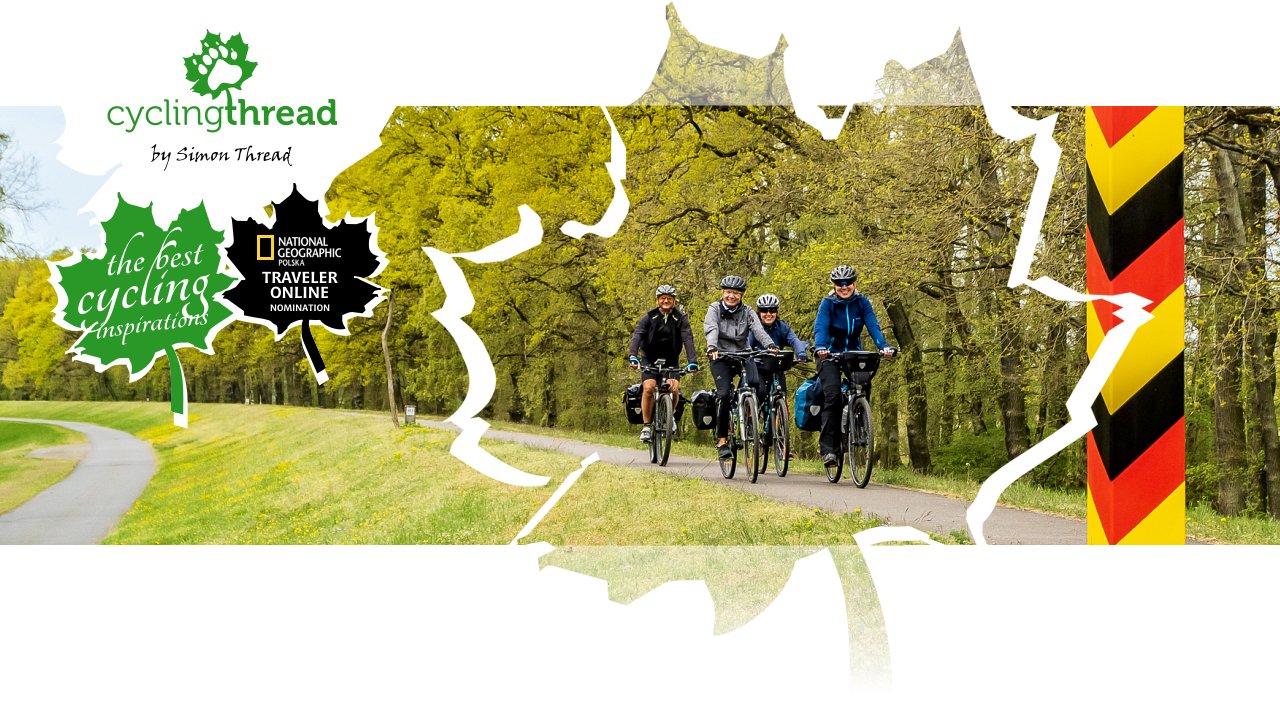
Oder-Spree-Tour, a truly cyclist-friendly Brandenburg
Tradition is sacred. After a two-year pause caused by the pandemic, we returned to the cycling routes of Germany for the long May weekend. Our comeback across the Oder was a resounding success, as for this special occasion, we chose Brandenburg, where we once began our exploration of Germany by bike. From the 7,000 kilometers of bike paths and dozens of routes in Brandenburg, we selected the nearly 300-kilometer Oder-Spree Tour. The Oder-Spree Tour is a four-day loop through the forests, lakes, rivers and canals of the Oder-Spree Lakeland, stretching between Frankfurt (Oder) and Berlin.
Route on the map
GPX file (GPS track): cyclingthread.com-brandenburg-2022.gpx
The Oder-Spree-Tour - table of contents
- The cycling route between the Oder and the Spree
- The Oder-Spree-Tour - basic informations
- Building bridges in Frankfurt an der Oder
- 40 kilometers on the Oder-Neisse cycling route
- Eisenhüttenstadt - Germany's most unusual city
- Traces of the Red Army on power plant chimneys
- An opportunity for fascinating cycling observations
- The monastery in Neuzelle with the Heavenly Theater
- In May in Germany, it's always asparagus time
- Comfortable cycling roads of Brandenburg
- Unified system of route signage
- GDR open-air museum comes alive
- The most beautiful bike path on the route
- Castle, church, and the oldest building in Brandenburg
- Historical city centers of Brandenburg
- Cycling through the Oder-Spree Lakeland
- Jewish cemetery, drawbridge and inland dune
- Overnight stay at a Bett+Bike guesthouse
- Gothic churches and chapels of Brandenburg
- The only Tesla factory in Europe
- Spree with Oder-Spree and Frederick William canals
- Cathedral, modern market and transportation hub
- Excellent cycling roads along the Spree and canals
- Four locks on the Oder-Spree Canal
- The Frederick William Canal came first
- Cycling bridge to the Schlaube Valley
- Who is the Oder-Spree-Tour for?
- 7,000 kilometers of cycling roads
- Ambassadors of cycling tourism in Brandenburg
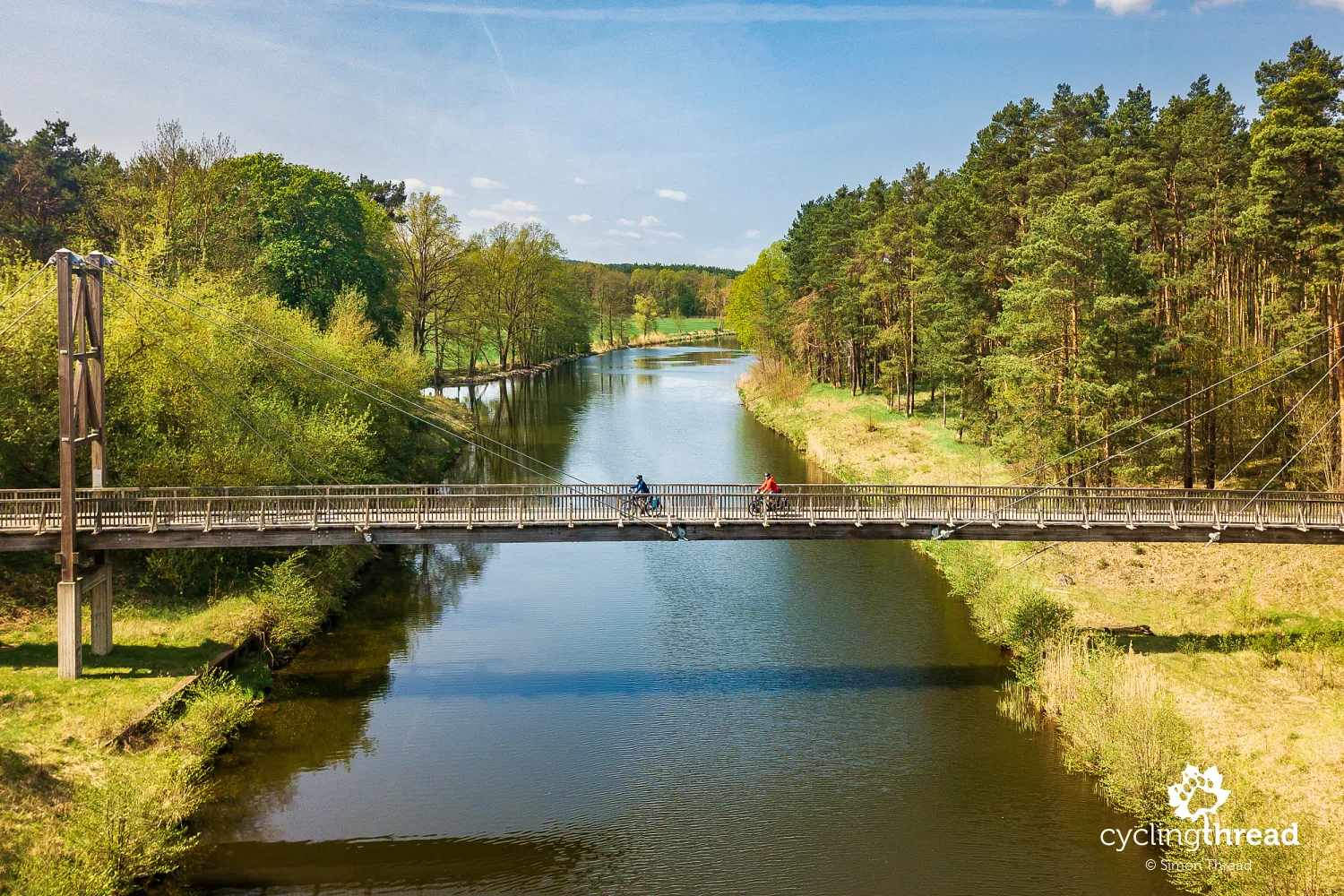
The cycling route between the Oder and the Spree
The name suggests a route along these rivers, similar to the Oder-Neisse cycle route, but that's not quite accurate. The Oder-Spree-Tour only follows the Oder for about 40 kilometers and the Spree for maybe a dozen kilometers. The name Oder-Spree-Tour should be understood more as a reference to the Oder-Spree Lakeland (Seenland Oder-Spree) area lying between these rivers, rather than a bike route that runs along their courses. What directly connects the Oder and the Spree are canals - first the Oder-Spree Canal, then its predecessor, the Frederick William Canal, over which our route takes us for many kilometers.
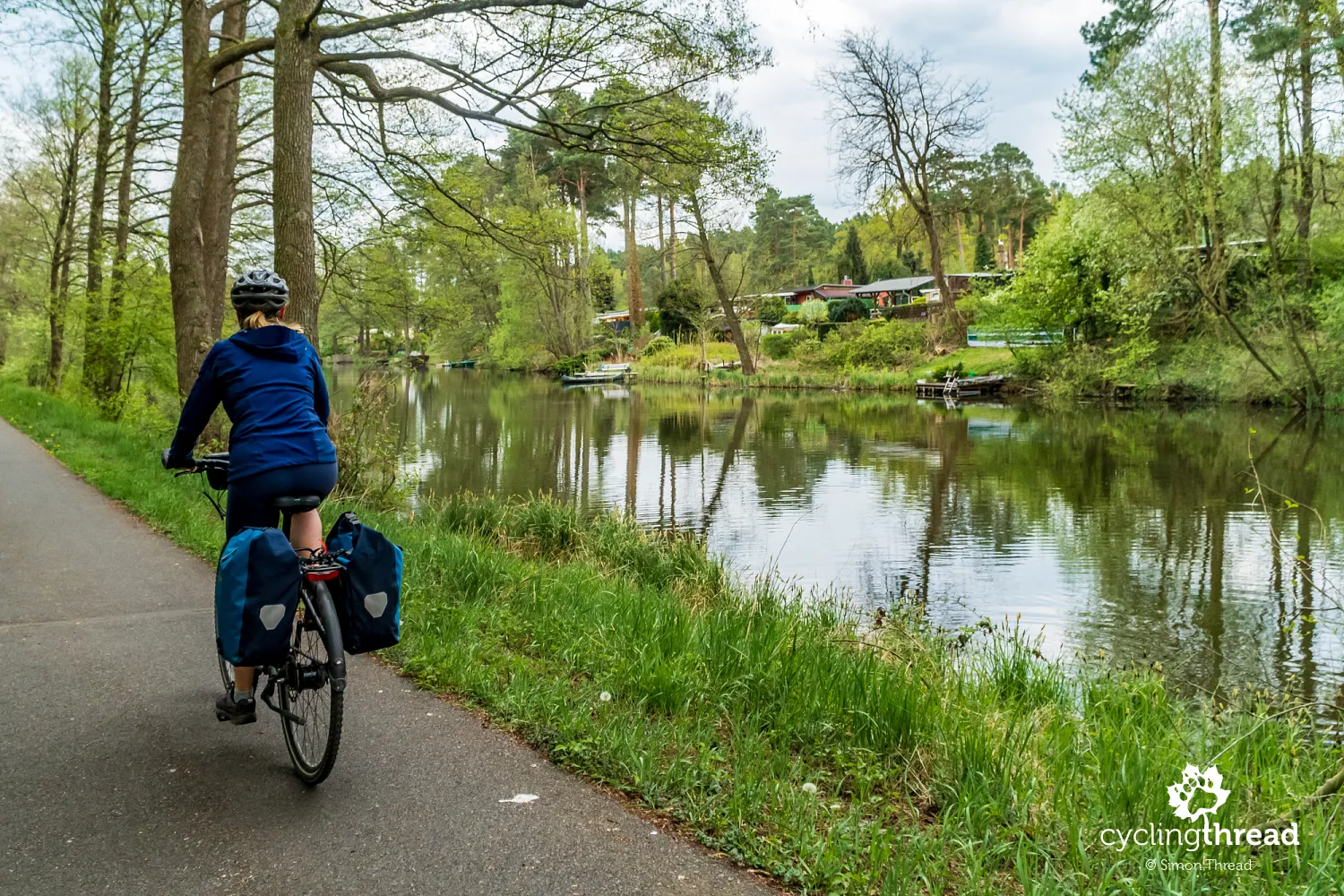
The Oder-Spree-Tour - basic informations
The Oder-Spree-Tour has an official length of 278 kilometers. During our 4-day trip on the route, which we began in Frankfurt (Oder) where we left our cars, we covered exactly 278 kilometers. However, we finished in Wiesenau, from where we took the last segment by train. You can get to Frankfurt by car, which can be left at the city's free parking lot for tourists. Frankfurt (Oder) can also be reached by train, which may be particularly useful considering the connections on the German side, allowing for route variants - a three-day journey from Frankfurt through Neuzelle, Beeskow to Fürstenwalde, as well as a one-day option - from Fürstenwalde to Frankfurt. Importantly, the majority of the route runs on bike-only roads or forest roads closed to car traffic.
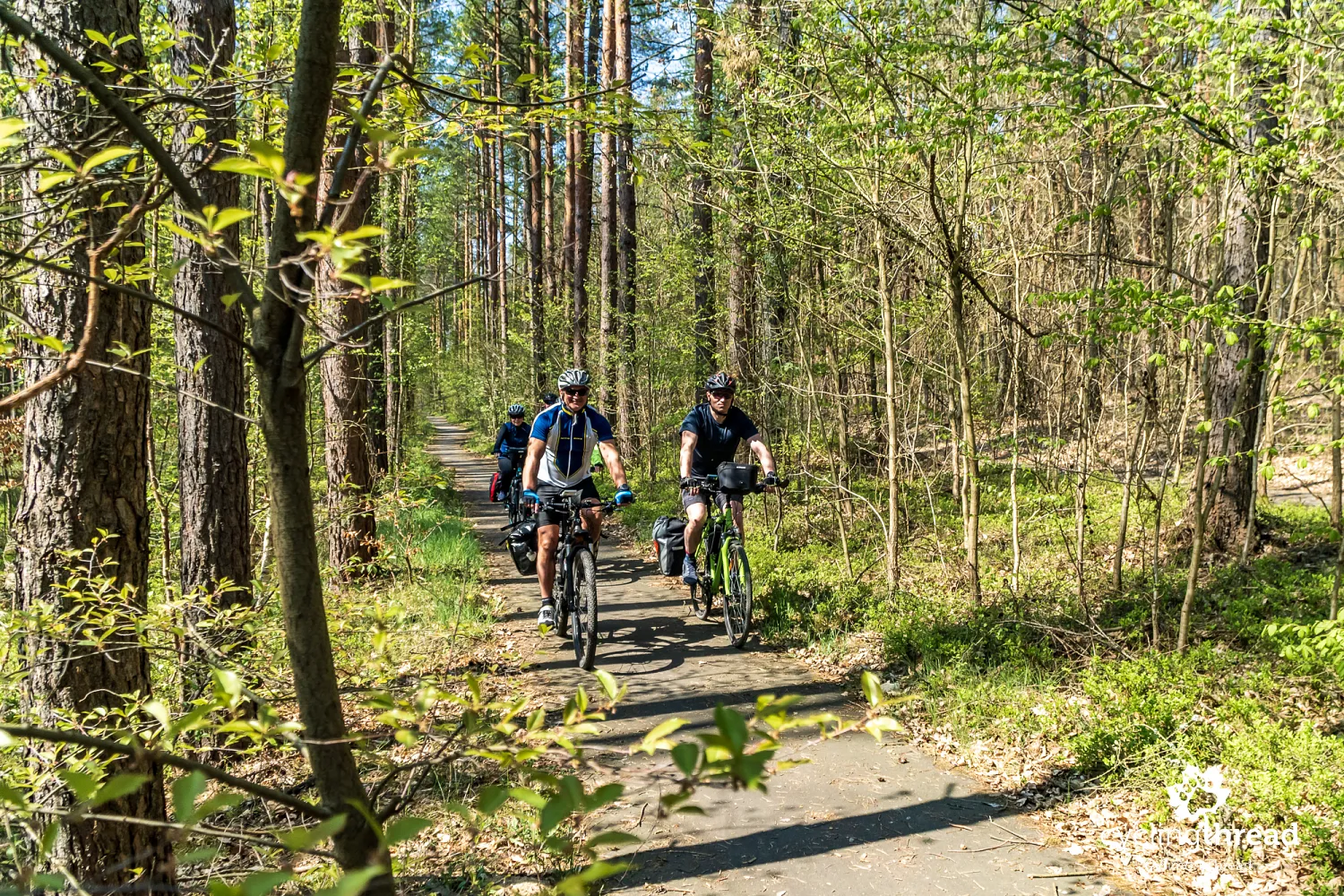
Building bridges in Frankfurt an der Oder
Our trip began in Frankfurt (Oder) with an efficient, hour-long city tour with a guide, whom you can ask about at the Polish-German Tourist Information in the city center. Our route included historic sites such as the St. Mary's Church, the currently renovated Town Hall, or St. Gertrude's Church, which survived or were rebuilt after the destruction of World War II, which nearly completely devastated the city. We also visited the European University Viadrina, saw the so-called Stolpersteine - memorials to Jews who once lived in Frankfurt, and saw the Oderturm - the tallest building in Brandenburg. Today's Frankfurt may not be a city that takes your breath away, but the plans it has and the enthusiasm of the people involved in them put the city in a positive, friendly light.
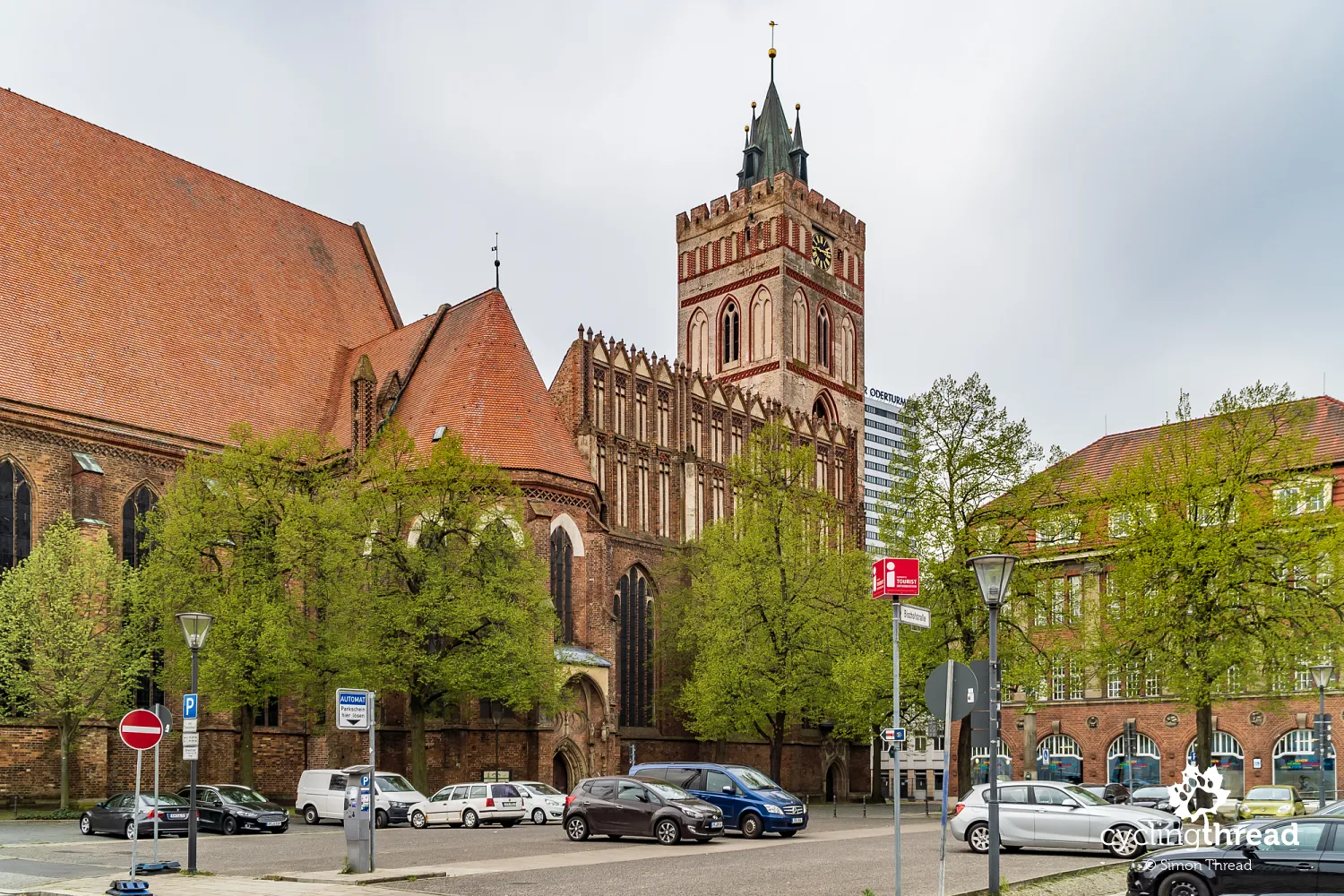
Plans for Frankfurt (Oder), supported by the federal government of Germany, include efforts to build the Future Center for German Unity and European Transformation. The new facility in Frankfurt aims to build social bridges - from the past to the future, from Germany to Poland, from the Oder to Europe. The institution is intended to be similar to, for example, the European Solidarity Centre in Gdańsk (EuroVelo 10), and undertake initiatives in the field of social transformation, science development, cultural and social activities. Currently, Frankfurt and Słubice, which before World War II were a district of Frankfurt, operate as a so-called Twin Town, coordinating many aspects of daily functioning. Meanwhile, the only bridge between Frankfurt and Słubice is usually congested - either by Poles going to work in Germany or Germans heading to shop in Poland.
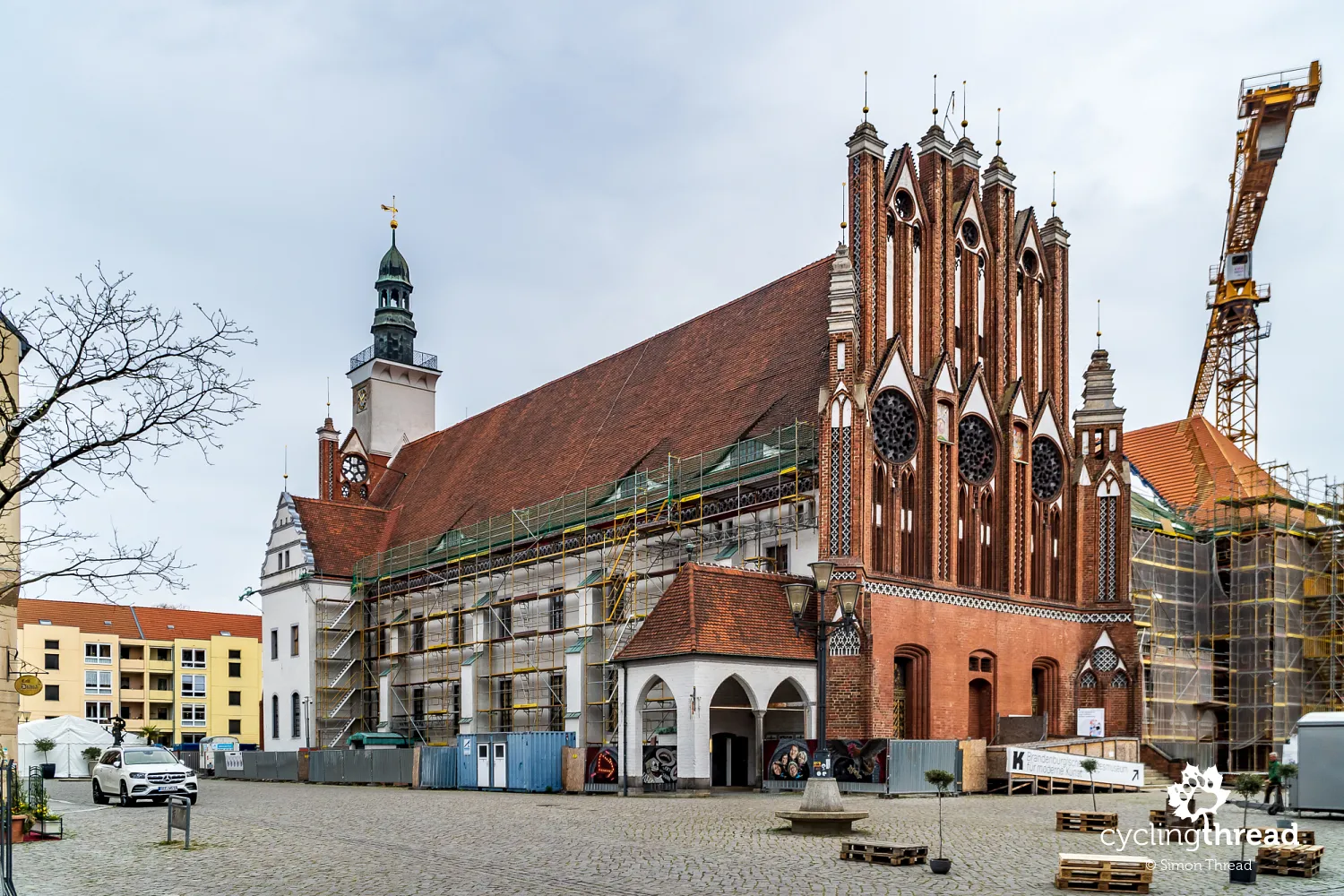
40 kilometers on the Oder-Neisse cycling route
The first 40 kilometers after leaving Frankfurt were spent on the Oder-Neisse Cycle Route (Oder-Neiße-Radweg), which initially served as an access segment for us and then ran together with the proper Oder-Spree-Tour. For Germans, the Oder-Neisse route is one of many long-distance cycling routes in Germany they can enjoy, and it sometimes even ranks in the top ten most popular routes in Germany. The Oder-Neisse route starts near the Czech town of Jablonec in the Jizera Mountains, ending in Ahlbeck on the island of Usedom on the Baltic Sea. A few years ago, I rode most of it, and shared my impressions in an article about the Oder-Neisse Route.
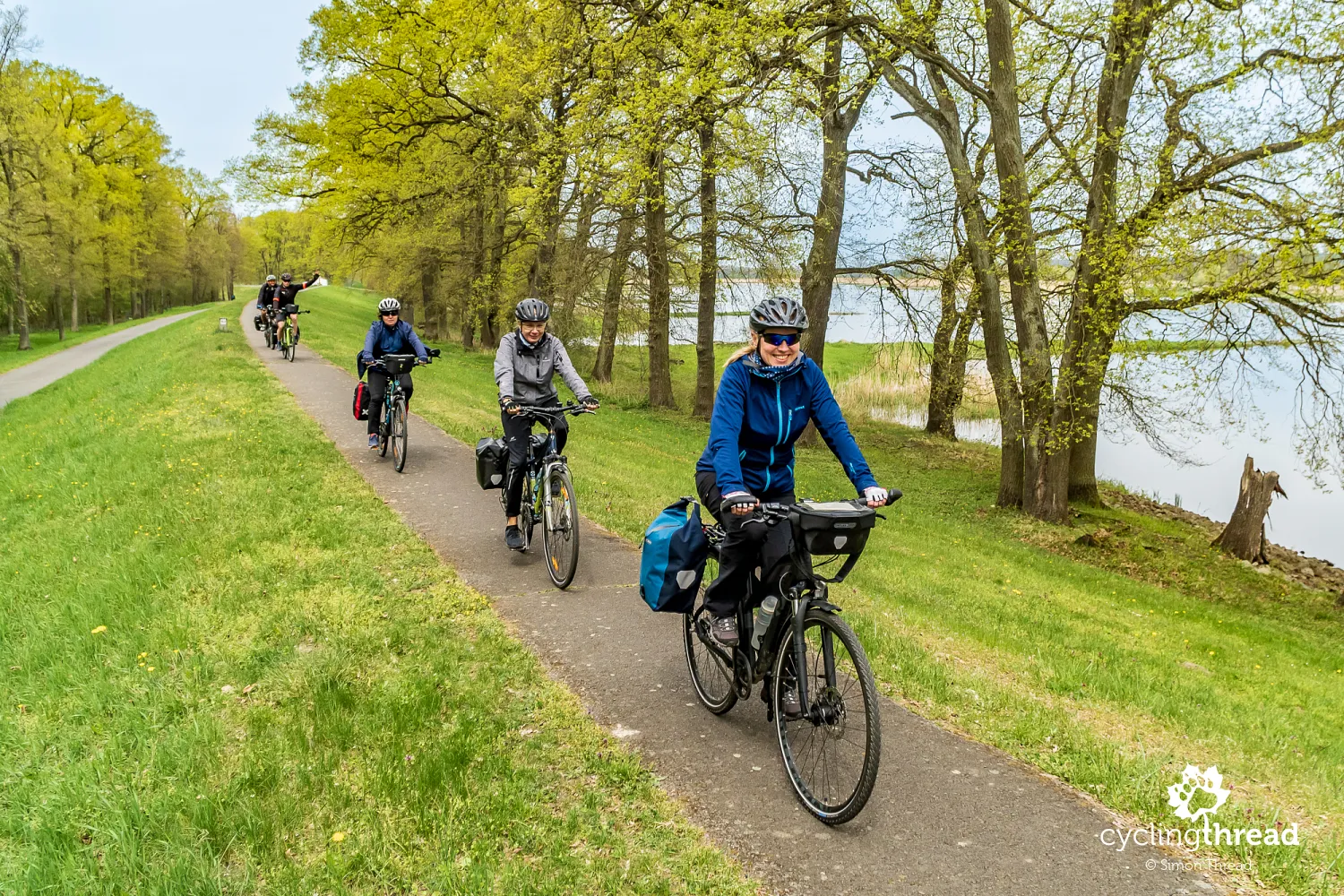
Not all cycling routes in Europe can boast such an immense connection with nature as enjoyed by cyclists traversing the path along the Oder and Lusatian Neisse. On the stretch we covered, there was just one city of 30,000 - Eisenhüttenstadt, which, moreover, is crossed by merely passing through a single, historic district. For the rest of the distance separating Frankfurt from Neuzelle, we delighted our eyes with the greenery and views of the wide Lower Oder Valley, unfolding from the high flood embankments. Occasionally, the narrow bike path running atop the embankment ends, guiding the cyclist onto a wide asphalt service road at the base of the embankment - at such moments, it's crucial to seize the opportunity to return to the embankment's crown as soon as possible, to make the most of the chance to admire the Oder riverscape.
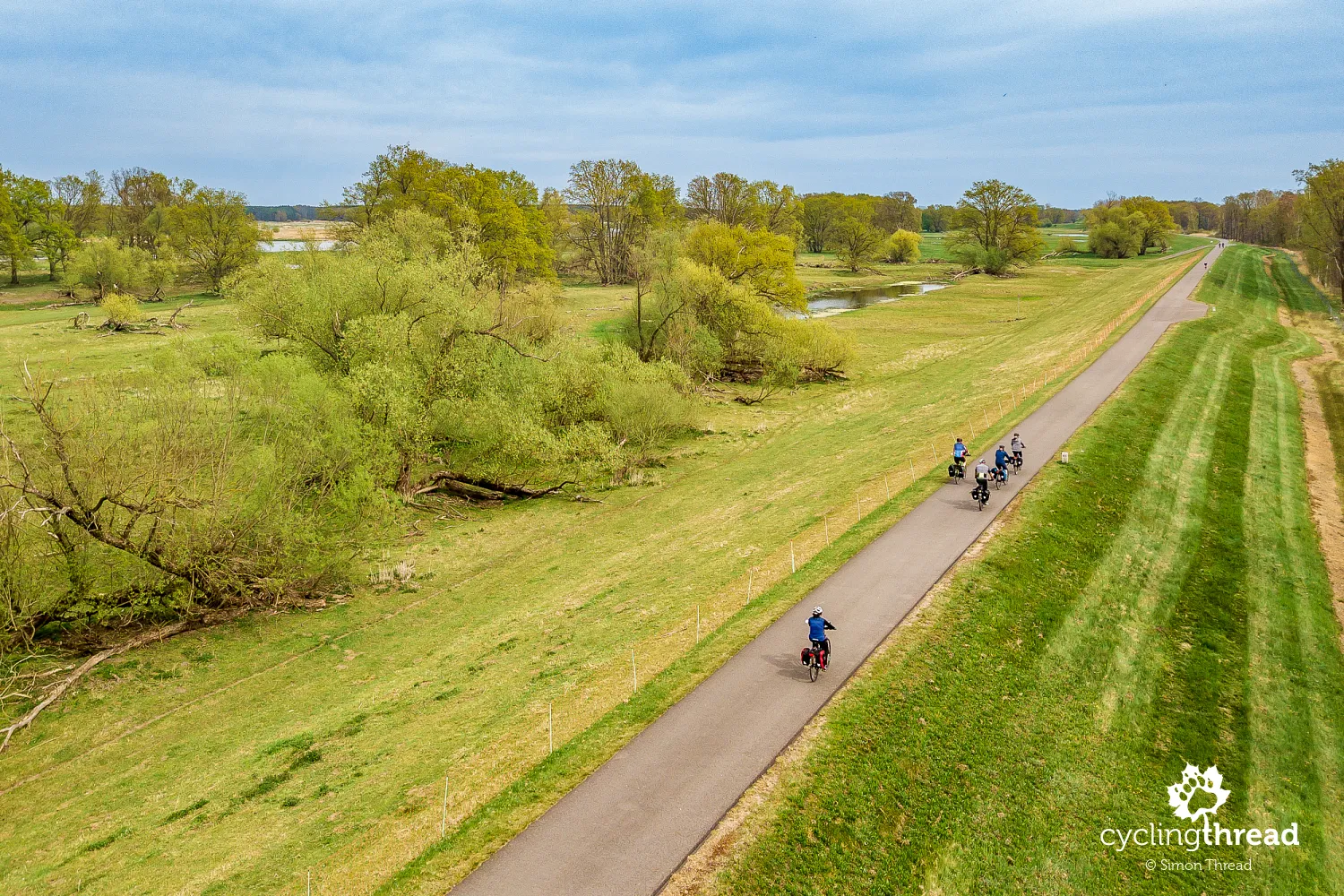
Eisenhüttenstadt - Germany's most unusual city
The mentioned Eisenhüttenstadt is often compared to Krakow's Nowa Huta, but it's also referred to as "the most unusual city in Germany." Eisenhüttenstadt was born from a residential settlement built for workers of the post-World War II ironworks. Initially named Stalinstadt - like Katowice, it was later merged with the historic Fürstenberg (Oder) and received its current name, literally translating to "ironworks city." Since it was planned and built from scratch, the socialist planners' designs from the 1950s have been perfectly preserved, making it perhaps the most modern city in Germany at the time. Today, the city's socialist classicism architecture and urban planning are its biggest attractions, though from the original 50,000 inhabitants of Eisenhüttenstadt, only about half remain. I write about Eisenhüttenstadt as an attraction near the route, although we decided to limit our visit to the historic Fürstenberg.
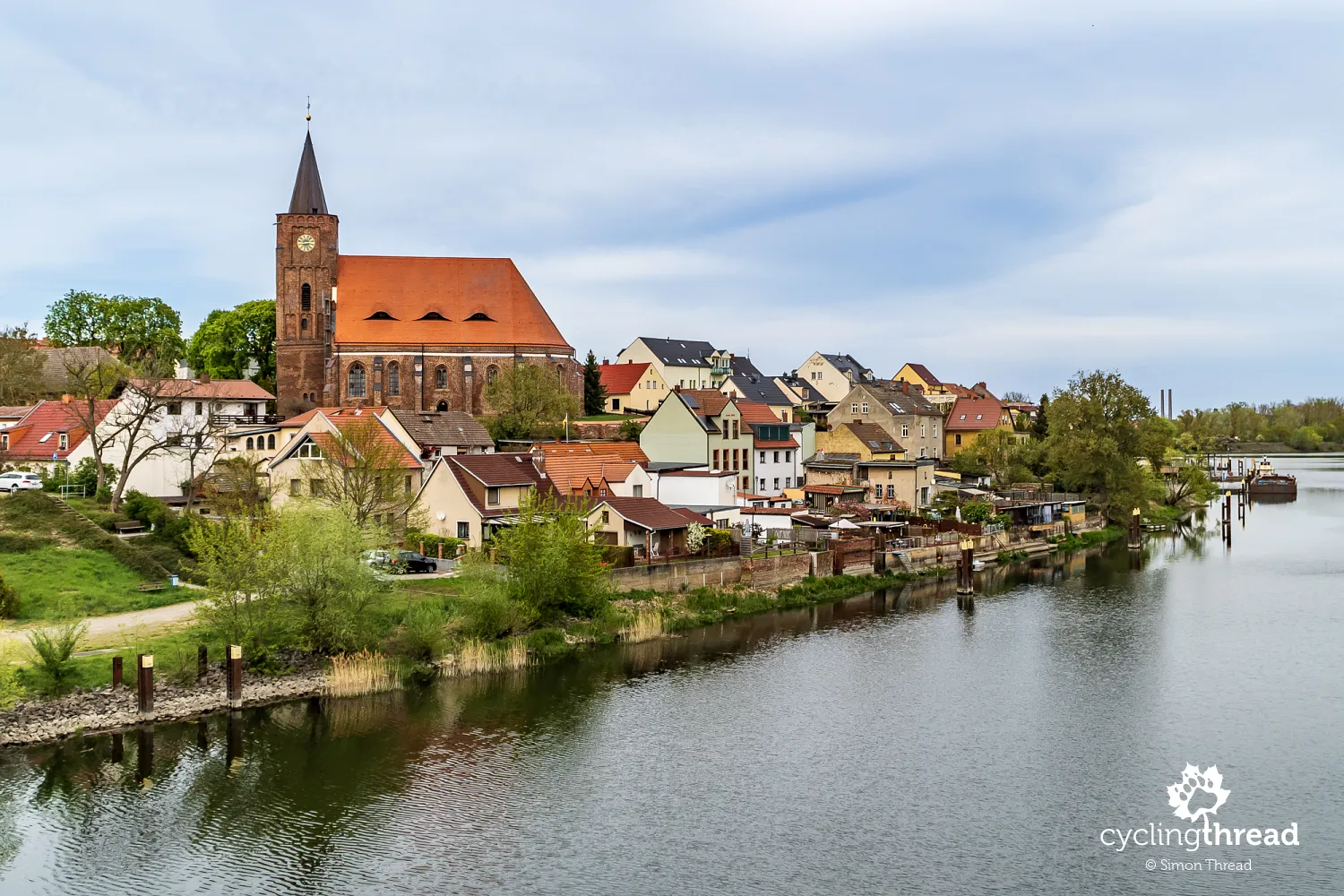
Traces of the Red Army on power plant chimneys
Just before Fürstenberg, two 100-meter tall chimneys with distinct damages spring up from the riverside landscape - the Vogelsang power plant. These seemingly uninteresting industrial ruins have been standing for almost 80 years. The construction of the Vogelsang power plant began in 1943 to satisfy the increased energy demand of the Third Reich's armament industry, with war prisoners and forced laborers working on it. Initial plans called for the construction of up to 15 identical facilities, but this was revised down to just five. However, the construction was never completed - it was halted in 1945 by the Soviet offensive, and it's the traces of the Red Army's shelling that can be seen on the chimneys of the power plant. After the war, the machinery and entire equipment of the power plant were transported to the Soviet Union. At the end of the last century, a decision was made to demolish the facility, which was stopped by environmentalists' protests - for decades, the power plant's ruins have become a habitat for birds and bats.
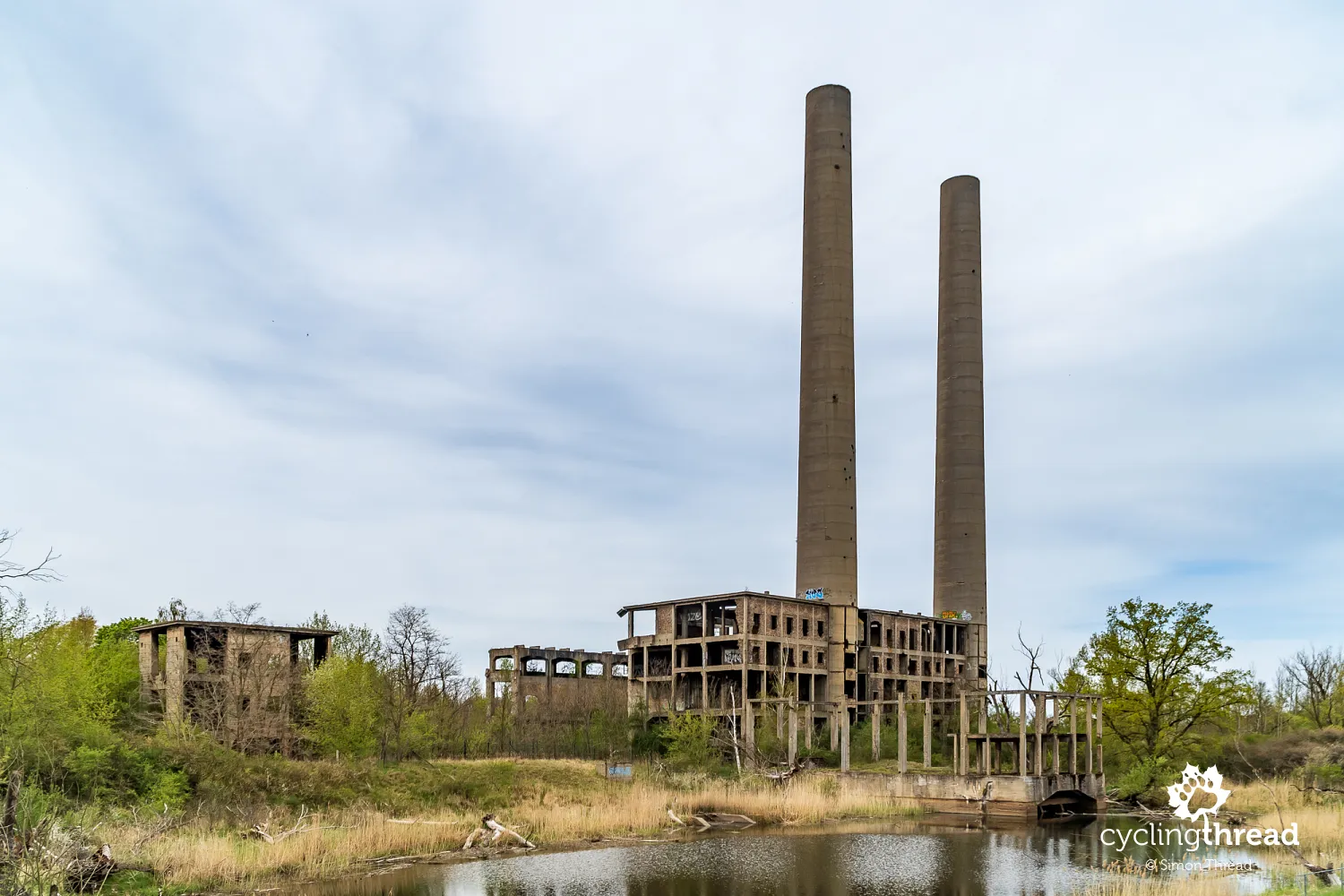
An opportunity for fascinating cycling observations
The popularity of the Oder-Neisse Cycle Route among German cycling tourists means that even a short ride like ours can be an opportunity for fascinating observations. In the roughly two to three hours we spent on the Oder embankments, we saw at least a dozen groups of cyclists (including couples) and probably twice as many solo cycling travelers. The immense diversity of those traveling by bike is heartening - with partners, friends, children, of all ages - cycling tourism in Germany is embraced by everyone. Touring - trekking bikes dominate, of course, but with a clearly visible trend of a large number of electric bikes. Perhaps the most charming was a cyclist transporting a dog in a trailer - the amount of luggage, an earpiece, expedition attire, and an electric bike indicated that this person was not just popping out for rolls to Frankfurt.
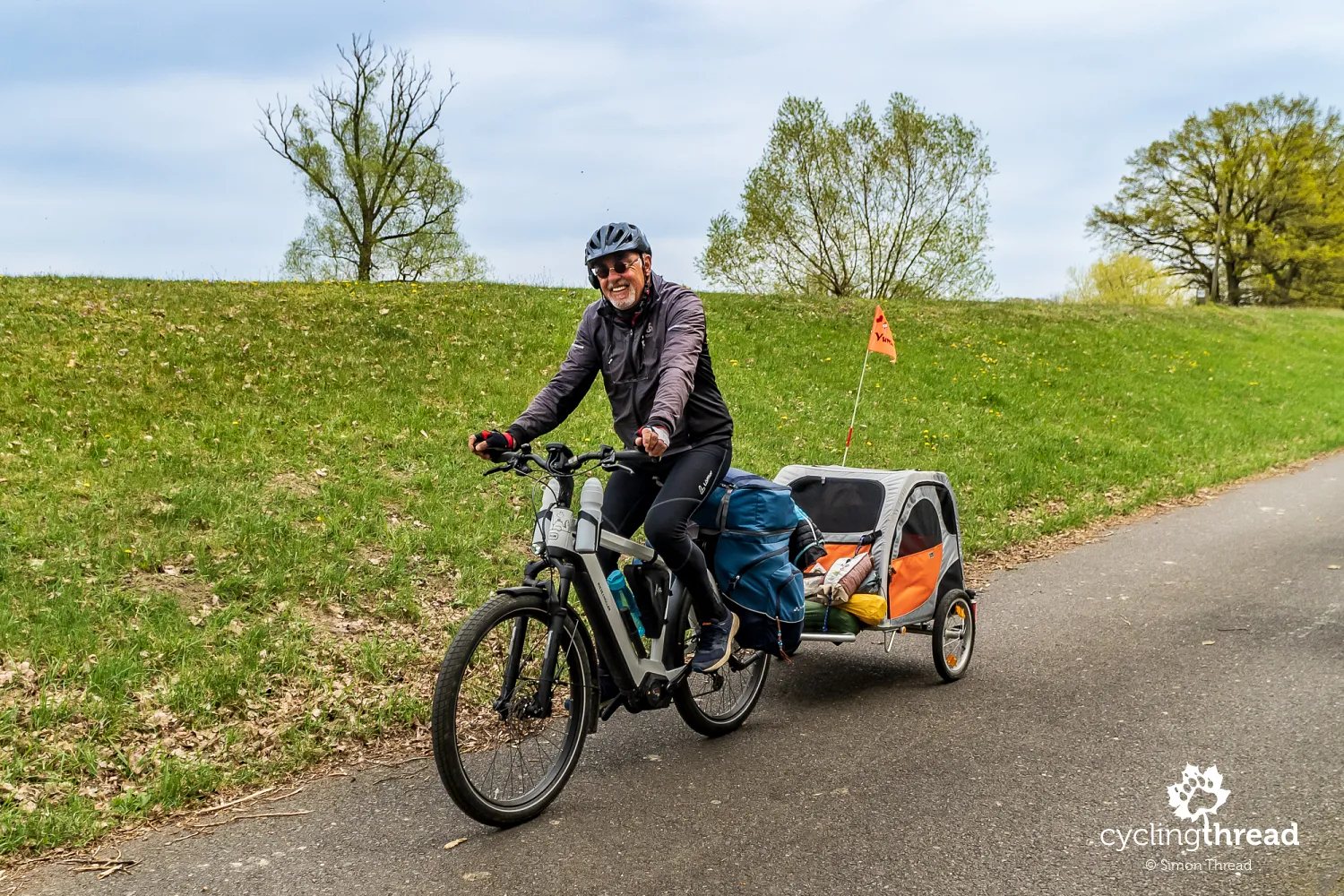
The monastery in Neuzelle with the Heavenly Theater
From the flood embankment, where the Oder-Neisse Route runs, we descend when far on the right side, the silhouette of the Cistercian monastery complex in Neuzelle becomes visible. Here, the Oder-Spree-Tour leaves the Oder embankments and now heads towards Berlin. The Neuzelle Monastery is called the "Baroque miracle of Brandenburg" and in 2018 celebrated the 750th anniversary of its founding. Throughout its history, it has survived intact in its original form. Unfortunately, we did not see the beautiful, rich interior of the Collegiate Church of the Blessed Virgin Mary - on weekends, the church is closed at 4 pm. However, we managed to visit the smaller, Protestant Church of the Holy Cross, walk through the monastic garden, and glance at the orangery within. It's a place worth remembering when traveling on the Oder-Neisse route - in fact, a few years ago, one of the detours designated during road works on the route went through Neuzelle.
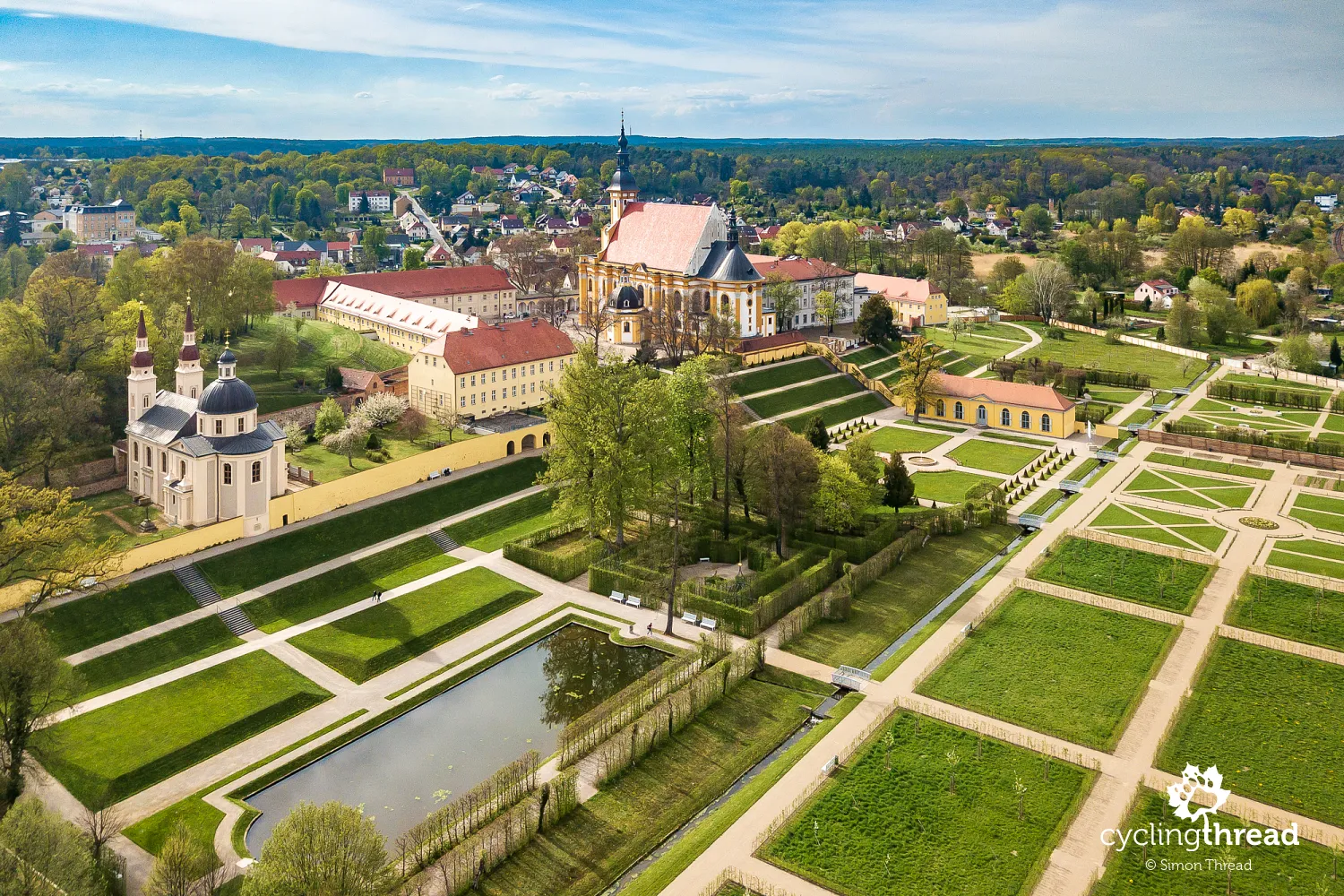
Fortunately, we saw a unique place, the Heavenly Theater Museum, located in the building of the former carriage house opposite the collegiate church. In a dim, high room, two structures resembling stages in a small theater are displayed. Each consists of two rows of several wooden panels covered with painted material, forming a multidimensional scene. The oldest presented stage elements date from the 18th century and - all depict events related to the suffering, death, and resurrection of Jesus Christ. There are five scenes preserved in the monastery in Neuzelle, of which just two are displayed. With its uniqueness, the “theater” from Neuzelle reminded us of another unusual artifact of sacred art, the preserved original Lenten veil, which can be seen in Zittau (more about it in the text about the Oder-Neisse Route).
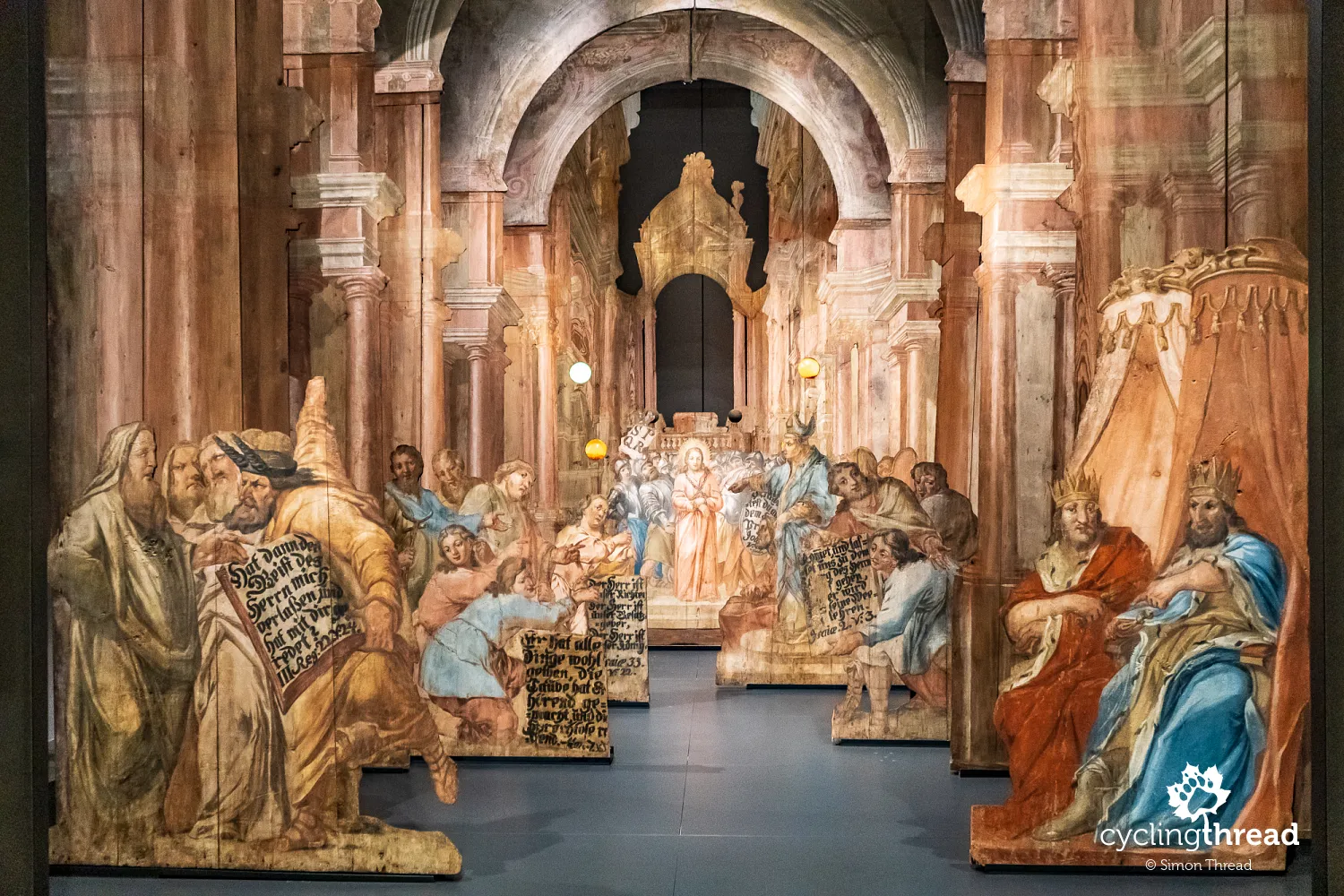
In May in Germany, it's always asparagus time
Right next to the monastic buildings in Neuzelle, a local brewery and restaurant operate. And such a combination always sounds to us like a good opportunity for a longer stop and a break from cycling. What landed on our plates? Of course - asparagus, Germans' favorite vegetable, without which one cannot imagine a May trip to Germany. Among the vegetables cultivated outdoors, asparagus plantations occupy the largest area in Germany. Meanwhile, Brandenburg is one of the three regions where the most are harvested. As a result, the May menu of almost every restaurant includes asparagus soup and schnitzel with asparagus and hollandaise sauce. The next day, in a pleasant Italian tavern right on the Spree in Beeskow, we even found (and of course ordered) asparagus pizza. Delicious!
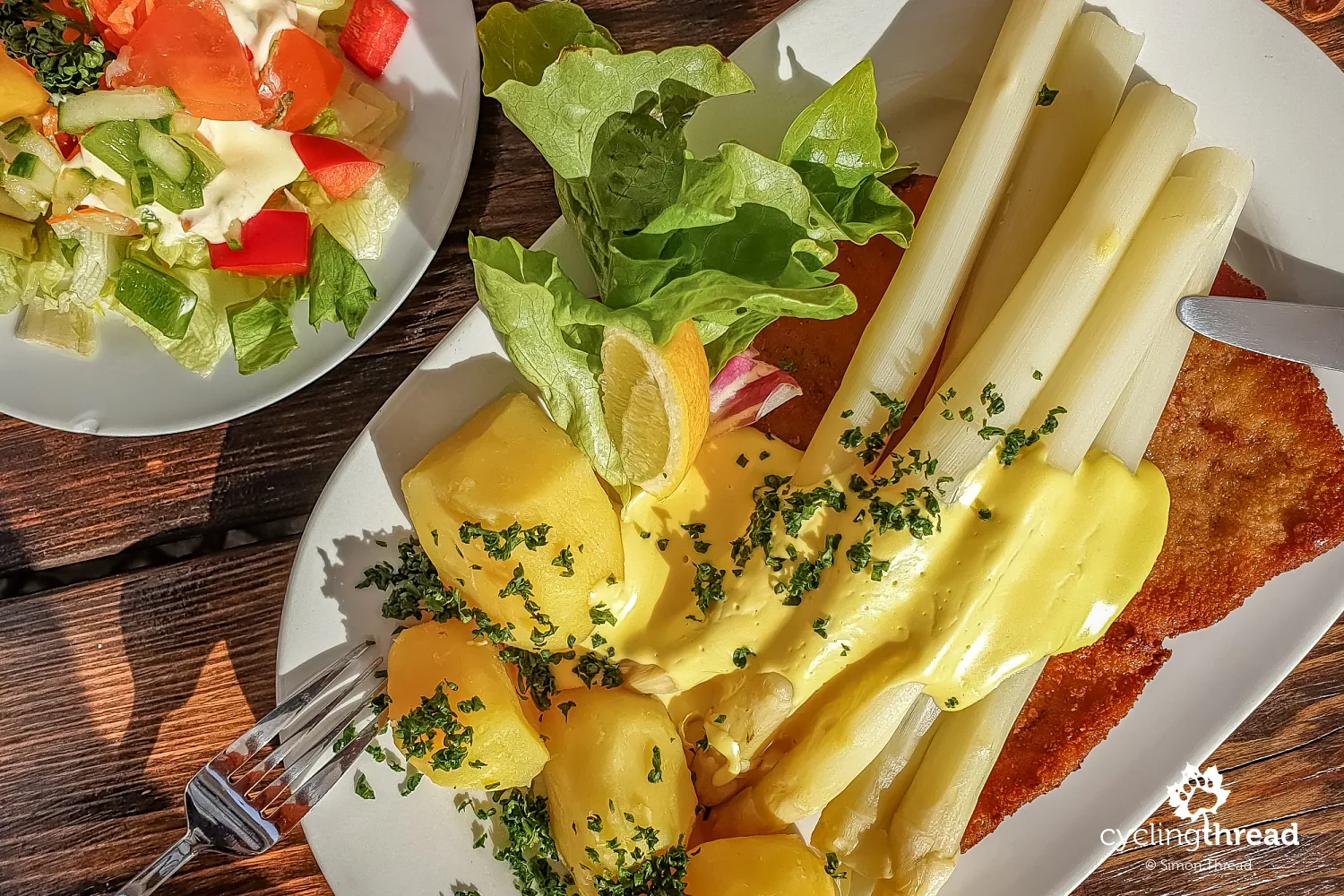
Comfortable cycling roads of Brandenburg
The ride from Neuzelle to our lodging by Wirchensee Lake, tucked away in the forest in the Schlaubetal valley, reminded us why we love cycling in Germany so much. On the few kilometers we had to cover, our route was accompanied by an excellent, wide bike path. Moreover - as far as I remember - it never ran just alongside the road, on the contrary - it often entered the forest, moving a few to several meters away from the road, reminiscent of the Kashubian Route in the Tuchola Forest. It's precisely such well-constructed cycling infrastructure that ensures comfort and safety on cycling trips in Germany. Over the next three days of riding, we had many opportunities to marvel at the quality of cycling roads in Brandenburg.
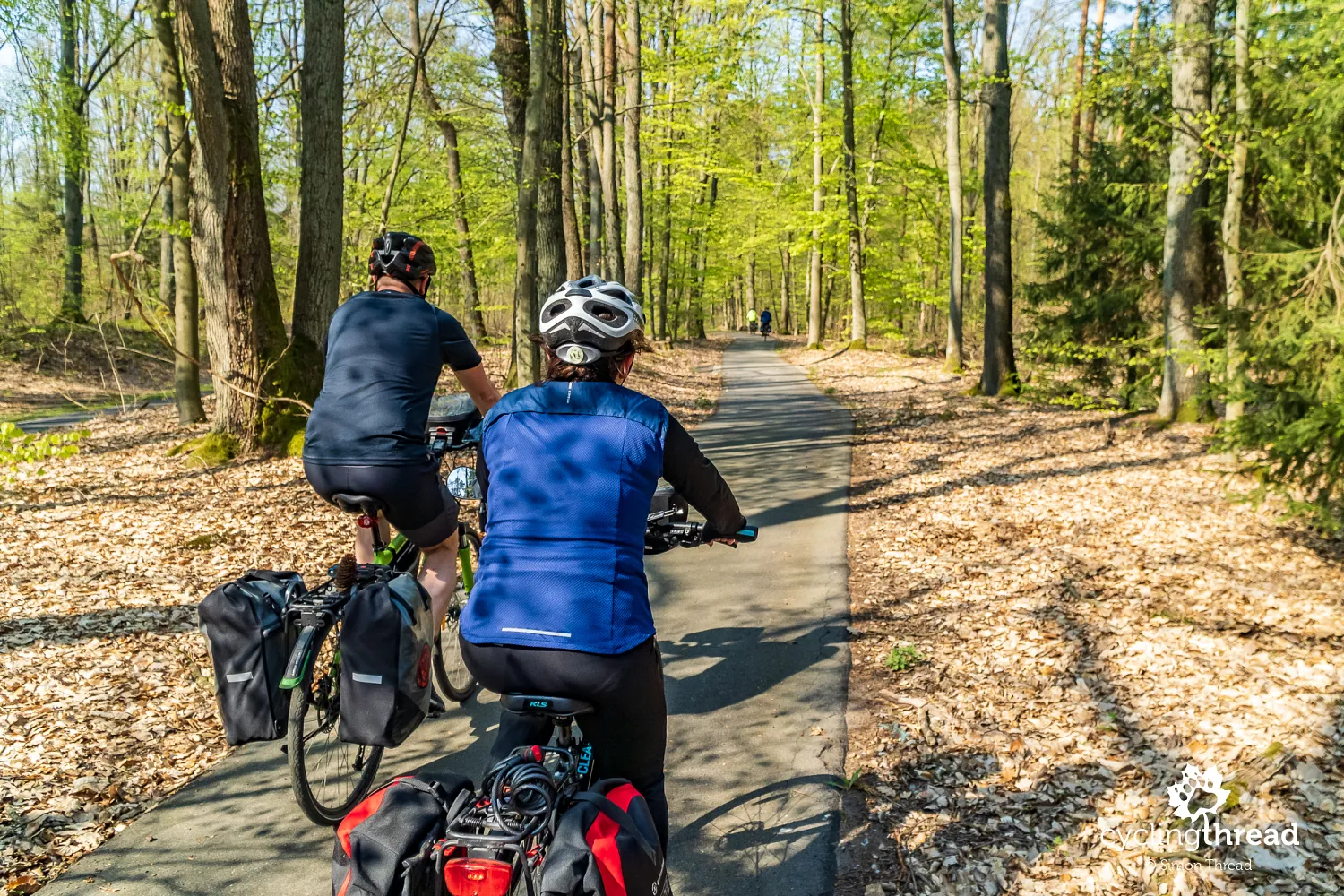
Unified system of route signage
A part of this cycling convenience is the uniform system of cycling trail signage across all of Germany. White-and-green signs with the names of towns stand from the Baltic to the Alps. A clear, bold font informs about the distance to the nearest, larger city on the route (above) and to the nearest town or facility (below), always providing cyclists with the most crucial information. Square plaques under the direction signs (less often above them) use a logo to inform about the cycling trail heading in the direction indicated by the signpost. During our May trip in Brandenburg, a black owl sitting on a bike against a yellow background - the symbol of the Oder-Spree-Tour - guided us. Another important trail visible in the photo is the Tour Brandenburg, Germany's longest cycling route, which we traveled on during two trips in previous years.
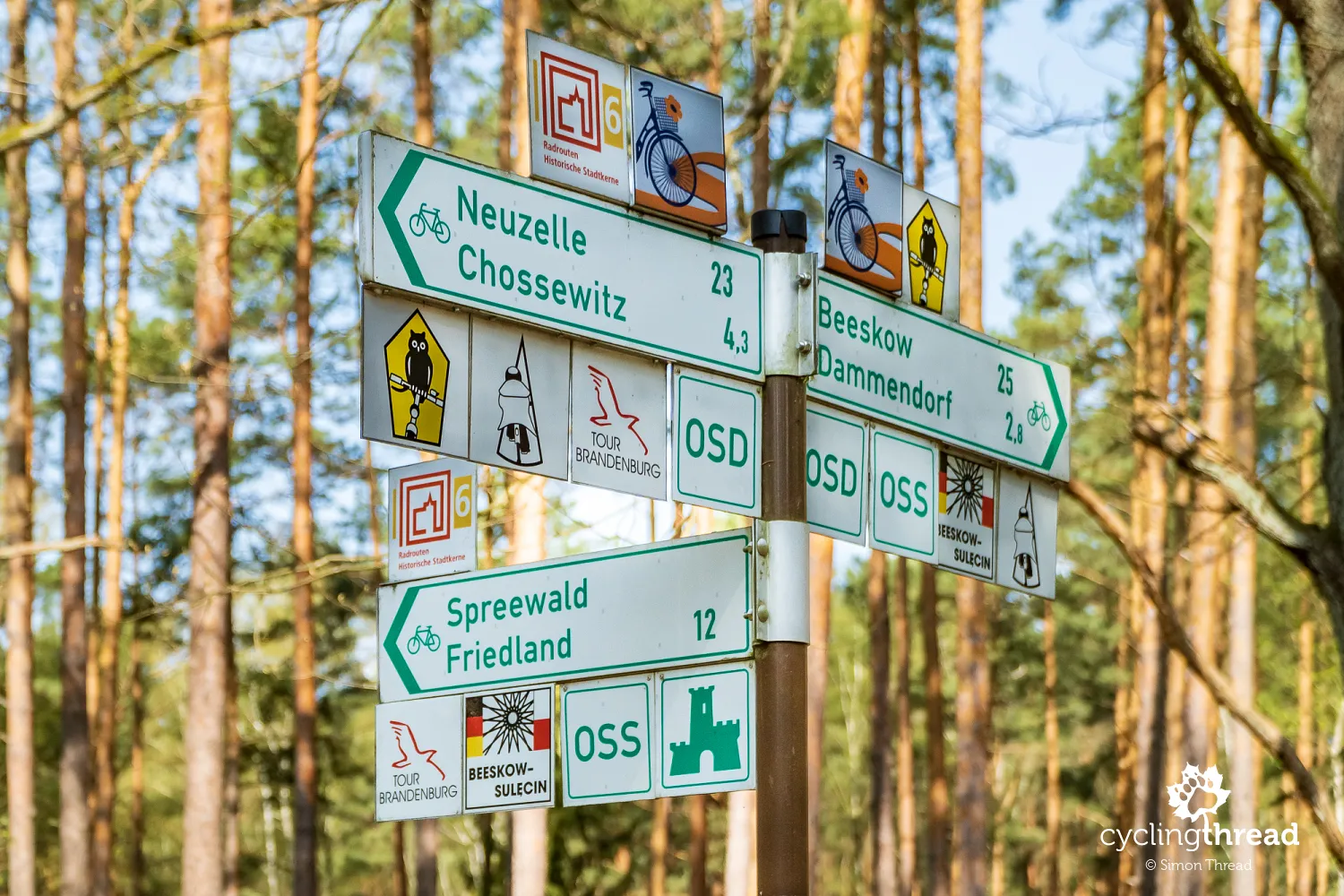
GDR open-air museum comes alive
An unusual scene started our second day. The atmosphere created by dozens of people in one Trabant and on several not-so-young mopeds and scooters manufactured during the German Democratic Republic era reminded us that we were in the former East Germany. This living motor vehicle museum formed a column on one of the side roads near the village of Dammendorf and then headed towards Beeskow. Who they were, why they gathered in a small village, why many of them looked as if they had been pulled straight from the DDR museum we visited while exploring Berlin by bike a few years ago - unfortunately, we do not know to this day.
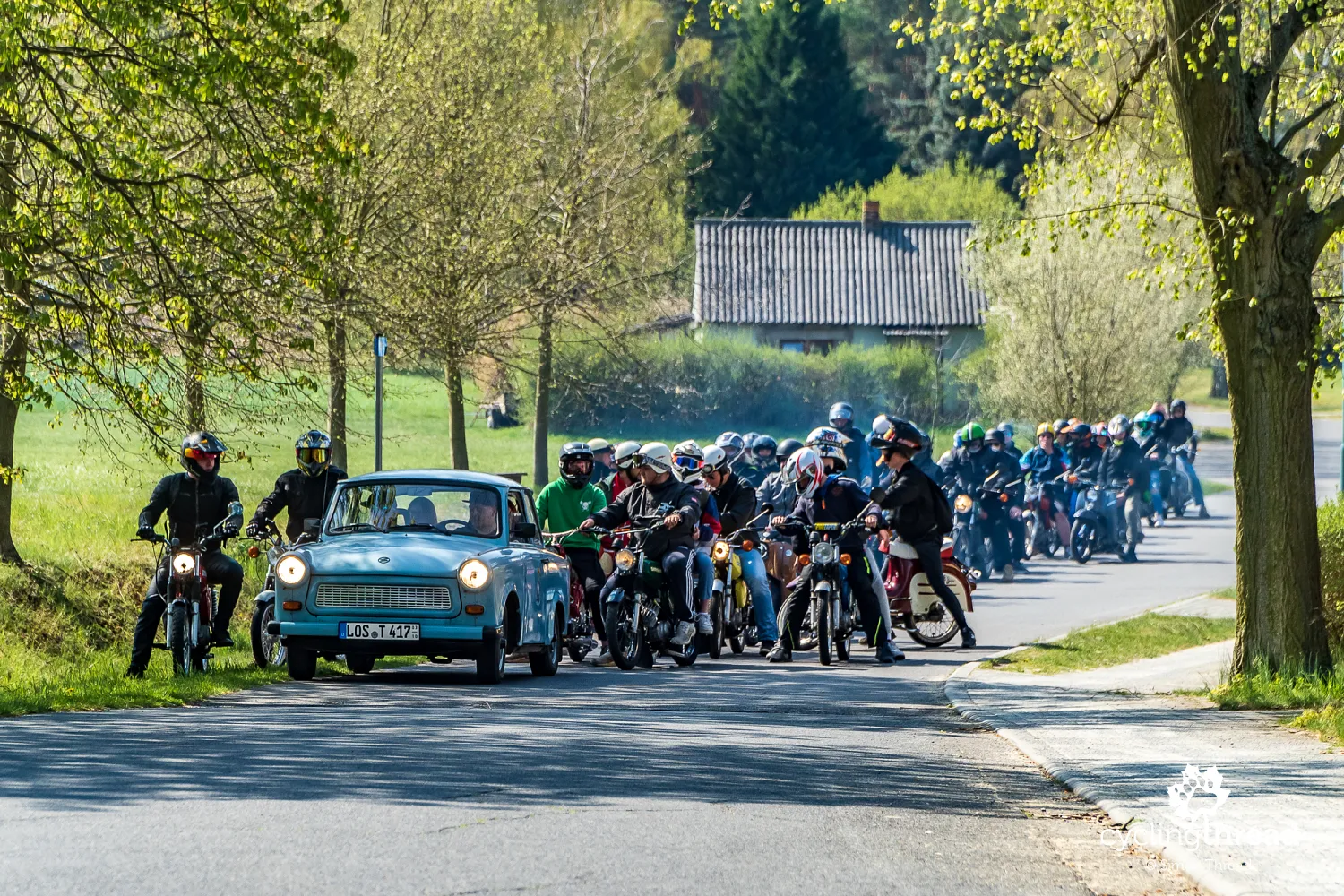
The most beautiful bike path on the route
Soon after that event, we stumbled upon one of the most beautiful bike paths of our entire trip and yet another example of how much can be done for the cycling tourist. In the Schlaubetal (Schlaube Valley), we rode on a roughly kilometer-long bike path led along the high bank of the secluded Hammersee Lake, through which the Schlaube River flows. The narrow asphalt track was finished on both sides with cobblestones, adding extra aesthetics to the route, but in this way - I suspect - introduced a charming element warning against getting too distracted and veering off the path. At the end of this path, on a high peninsula above the lake, we found the buildings of the Siehdichum forester's lodge with a café and a terrace overlooking the lake - at this time of day, it was the perfect place for a short break with coffee and cake. In terms of aesthetics, scenic attractiveness, and even its layout - giving the impression of gently sloping downwards - it's definitely one of the most beautiful sections of bike paths we've traveled. Especially with the surprisingly warm and sunny weather.
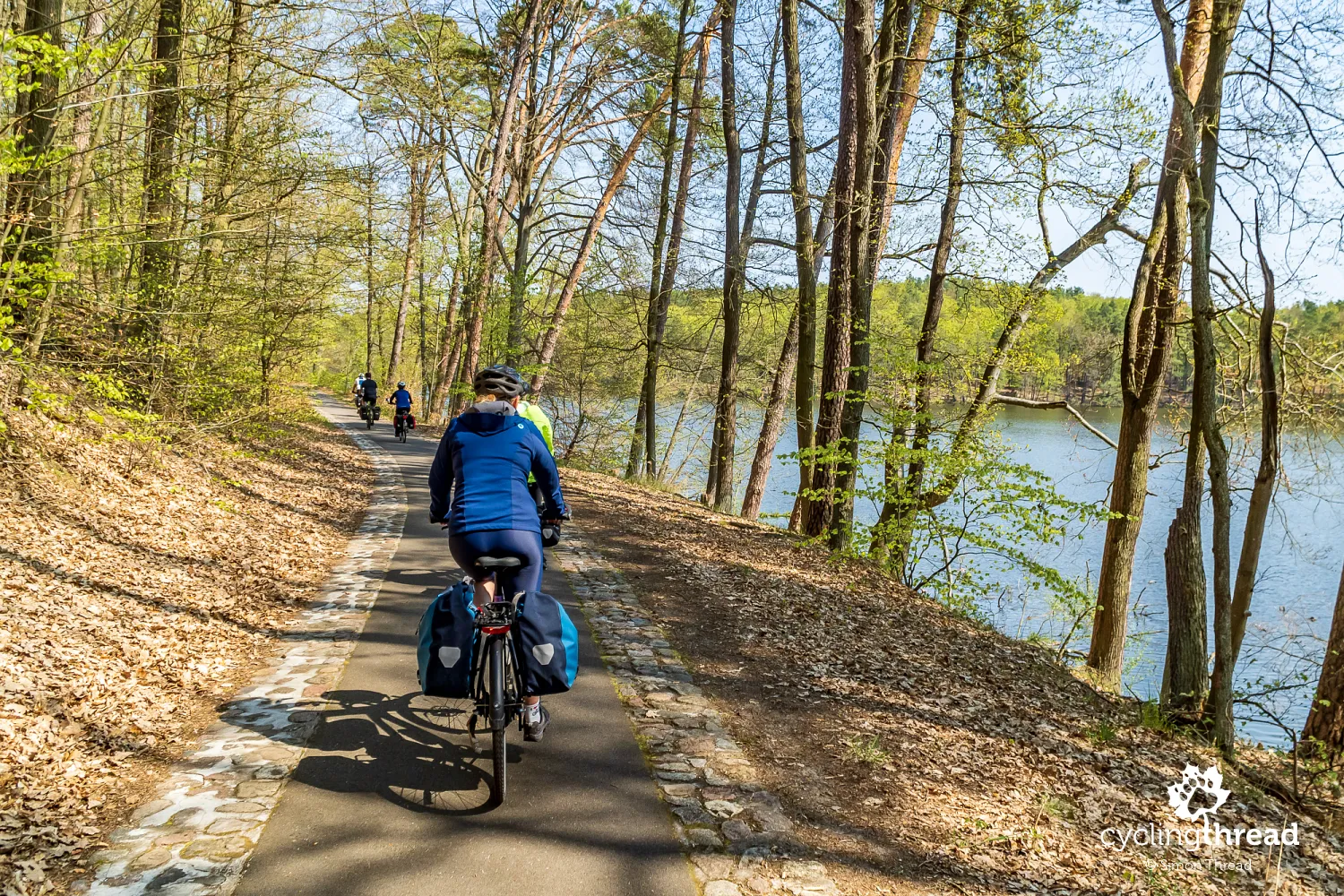
Castle, church, and the oldest building in Brandenburg
From Beeskow, apart from the already mentioned asparagus pizza by the Spree, we will also take away memories of a small, still-being-reconstructed castle near the Spree and a large, one of the biggest in this part of Germany, 14th-century Gothic church. And just before the main entrance to the St. Mary's Church stands the oldest preserved building in eastern Brandenburg. The building dates from the late 15th century, initially built as a granary, later serving as a residential building. It survived both medieval fires and the Soviet bombing in 1945, which destroyed a large part of the town. Today, it houses an open museum exhibition - a tiny urban open-air museum. From this place, a narrow street leads to the spacious market square in Beeskow.
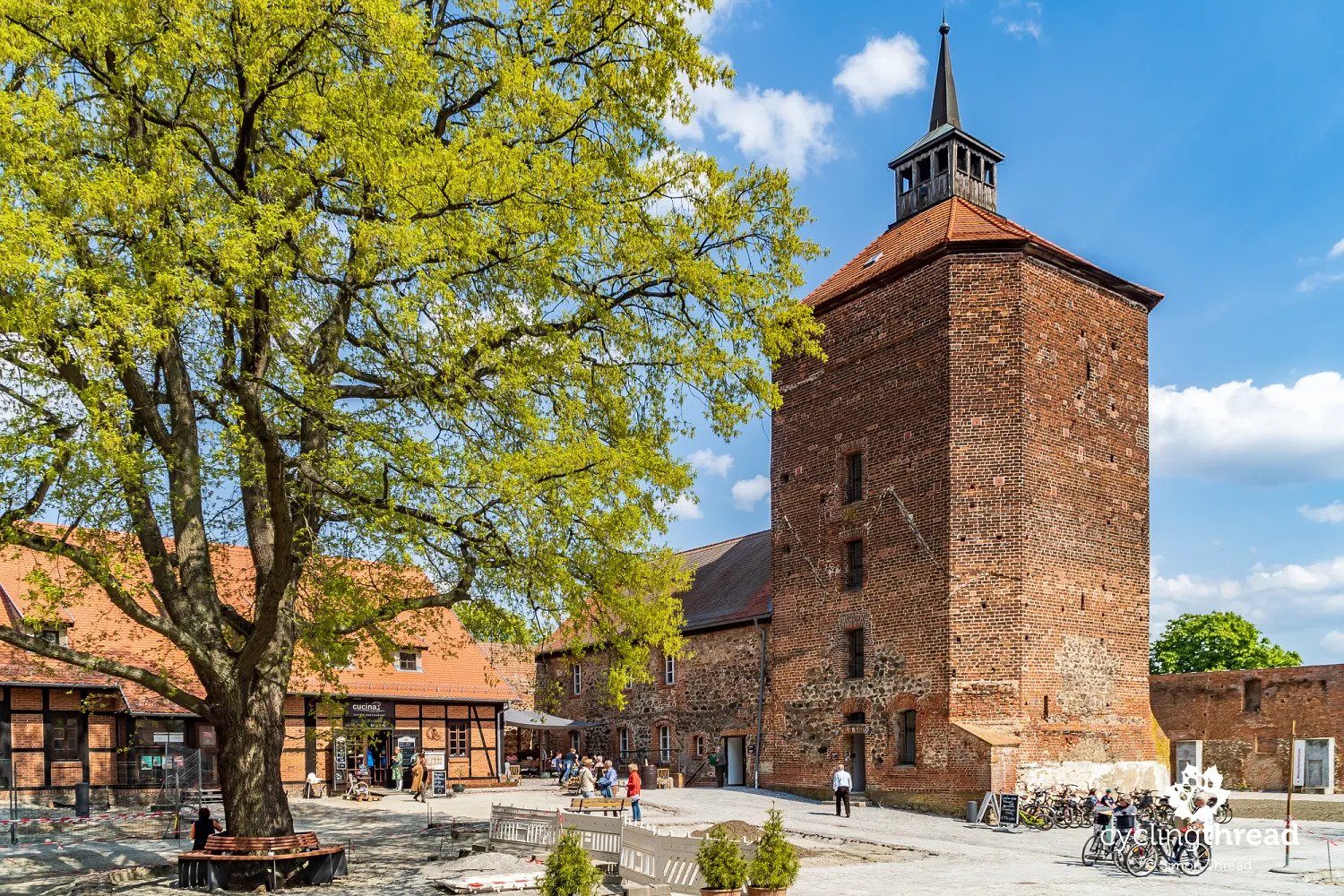
Historical city centers of Brandenburg
Beeskow struck me as very characteristic of this part of Germany, similar to several others we visited on our previous routes through Brandenburg. All belong to the "Historic City Centers" group, comprising cities with preserved old urban layouts and development policies that consider the care for cultural and historical heritage. Besides Beeskow, from the list of 31 Brandenburg cities with historic centers, we also saw Brandenburg an der Havel, Lenzen (Elbe), Lübbenau/Spreewald, Perleberg, Potsdam, Rheinsberg, Templin, Werder (Havel), and Wittstock (Dosse). All are associated with Gothic brick architecture, preserved city walls and gates, but also with the small-town, yet very pleasant atmosphere of German provinces.
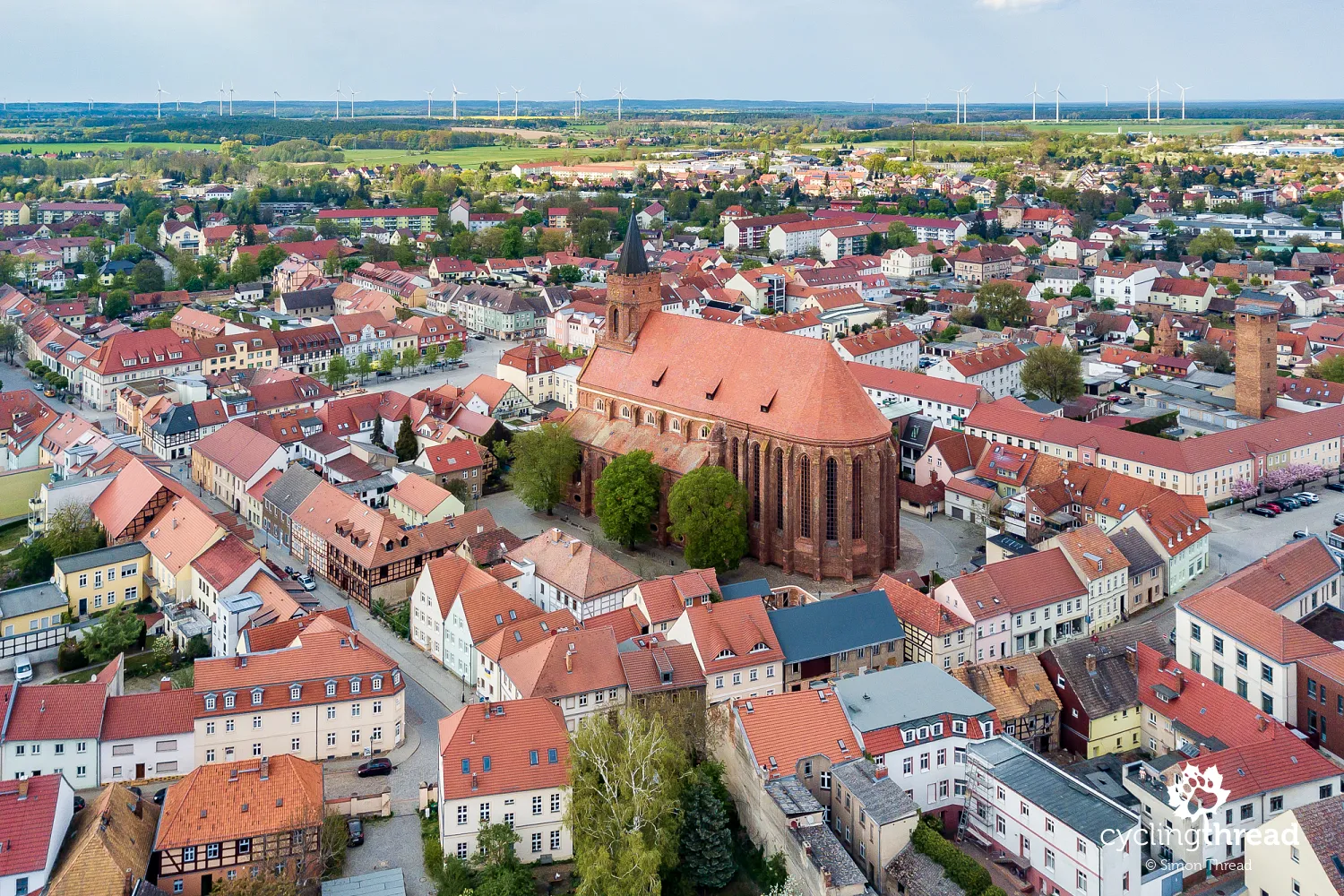
Cycling through the Oder-Spree Lakeland
Riding along two large lakes lying between Beeskow and Storkow reminded us that nearly our entire route lies within the Oder-Spree Lakeland (Seenland Oder-Spree). Though the name was created more for tourism-promotion purposes and is not the official name of any German geographical region, it quite accurately captures the character of this area. Among the recreational towns of the Oder-Spree Lakeland is Bad Saarow, situated by Scharmützelsee Lake, which in the 1920s, the heyday of German culture and art, was a popular meeting and relaxation spot for representatives of Berlin's artistic and cultural circles. Currently, the most popular attractions in the area include the thermal baths in Bad Saarow, operating thanks to the local brine water sources and surrounding peat bogs.
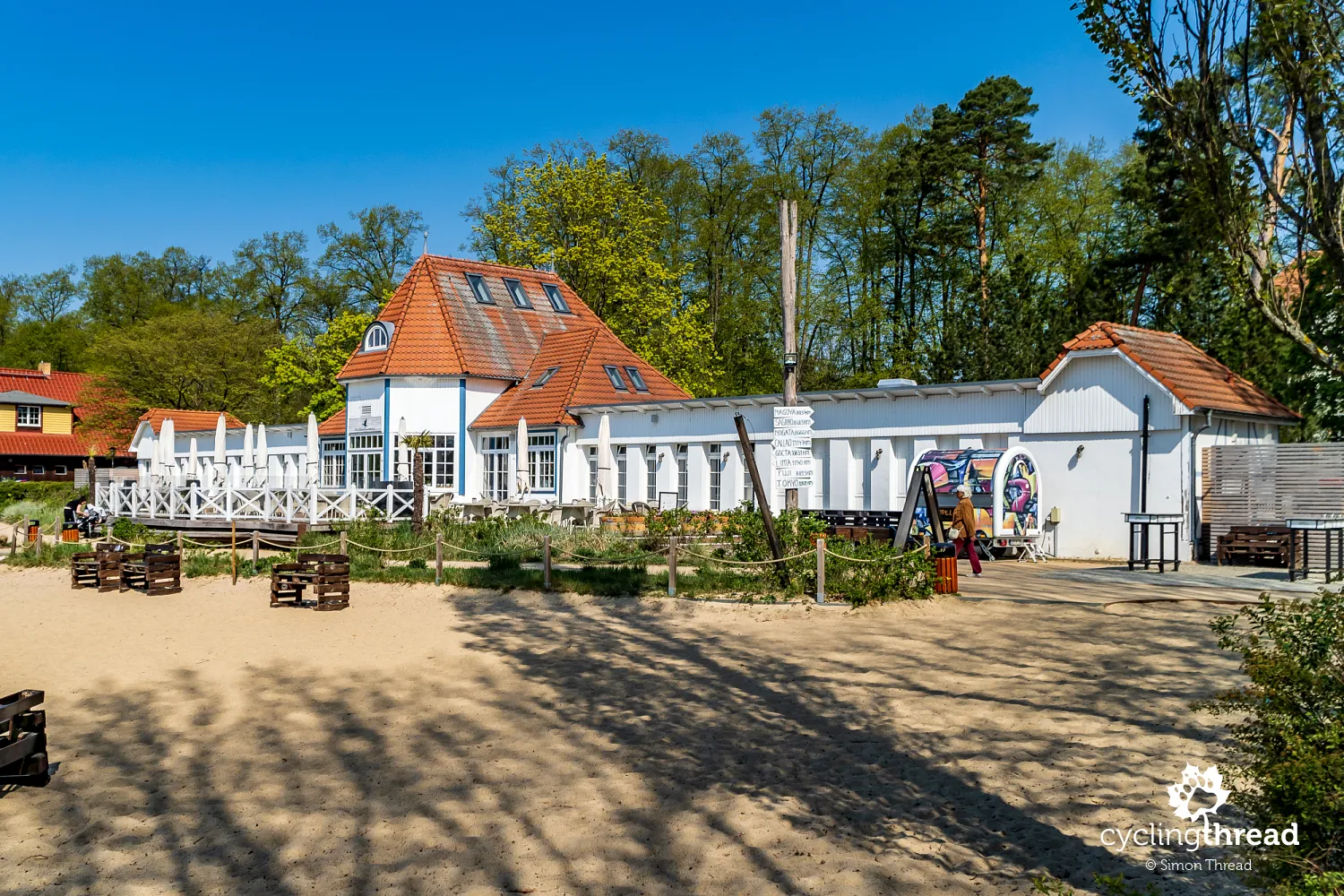
Jewish cemetery, drawbridge and inland dune
Another interesting spot on the Oder-Spree-Tour was the small town of Storkow, where we spent our second night. The most valuable site here is a small castle, similar to the one in Beeskow. Originating from the 13th century, it has only served in its current form for a dozen years, rebuilt after a fire in the 1970s. Storkow also features historic town center buildings and a renovated historic wooden drawbridge. Along the road that the route follows, there's also a well-kept Jewish cemetery, and a bit further, in a roadside forest, one can see the 69-meter-high Waltersberge dune, one of the largest inland dunes in Brandenburg.
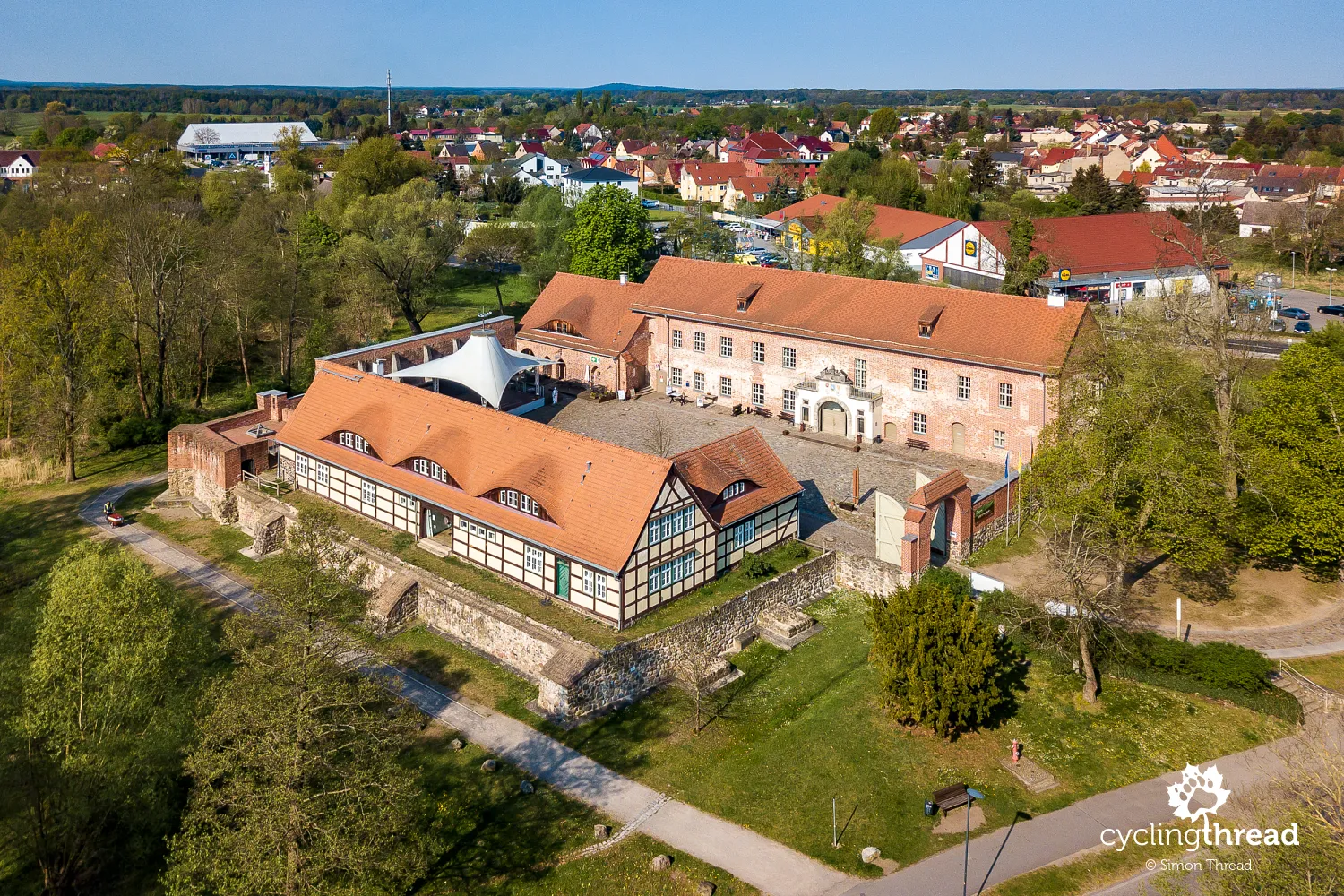
Overnight stay at a Bett+Bike guesthouse
In Storkow, we stayed at the Storchenklause guesthouse - one of nearly 50 lodging facilities of the Bett+Bike network located along the Oder-Spree-Tour cycle route. Bett+Bike is a German network of cyclist-friendly places, similar to the French Accueil Vélo system, which can be found, for example, along the Loire by Bike route. In all such lodging places, there is a garage or another lockable, secure room for bicycles, and the cycling tourist can also use basic tools and spare parts. As always on such occasions, I encourage planning well in advance and making reservations as soon as possible during trips to Germany . Due to the popularity of cycling tourism in Germany, the cheapest and best-located guesthouses and hotels are quickly booked. More accommodations in Brandenburg can be found by checking popular lodging websites.
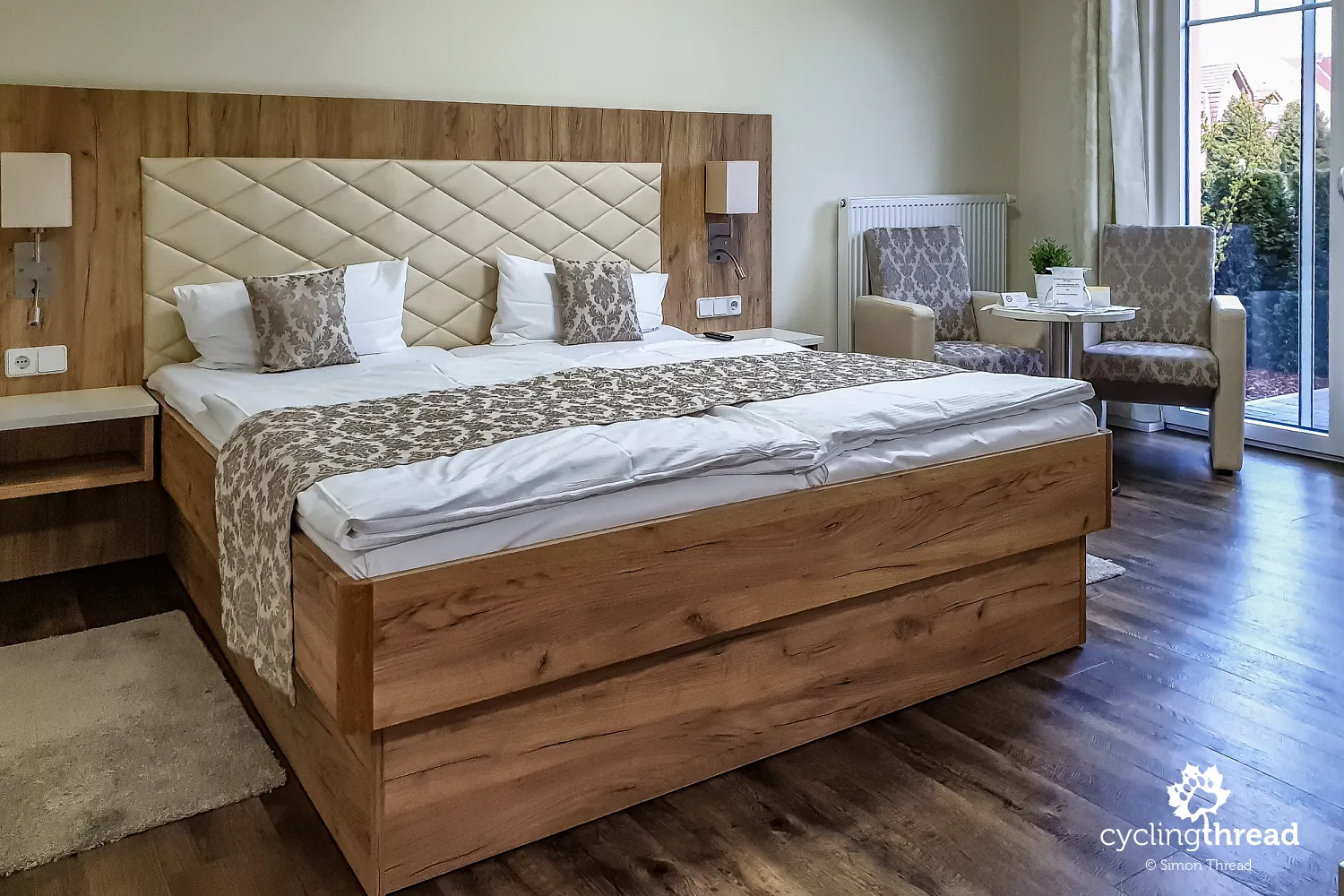
Gothic churches and chapels of Brandenburg
The southern part of the loop features an undulating glacial landscape, with a distinct old Prussian character evident in many older buildings. Besides monumental temples in Beeskow or Fürstenwalde, many Brandenburg villages have small, historic Gothic churches. Among them is the one in Möbiskruge, near Neuzelle - an early Gothic, hall church from the mid-14th century. Inside, there is a preserved altar from the 16th century, and one of the three bells is dated to the 17th century. Another is found in Merz, several dozen kilometers further - a 15th-century silhouette made of fieldstone finished with a half-timbered bell tower. All are well-maintained, belong to Evangelical congregations, and usually form the central point of the village, giving them a bit of a medieval sentiment.
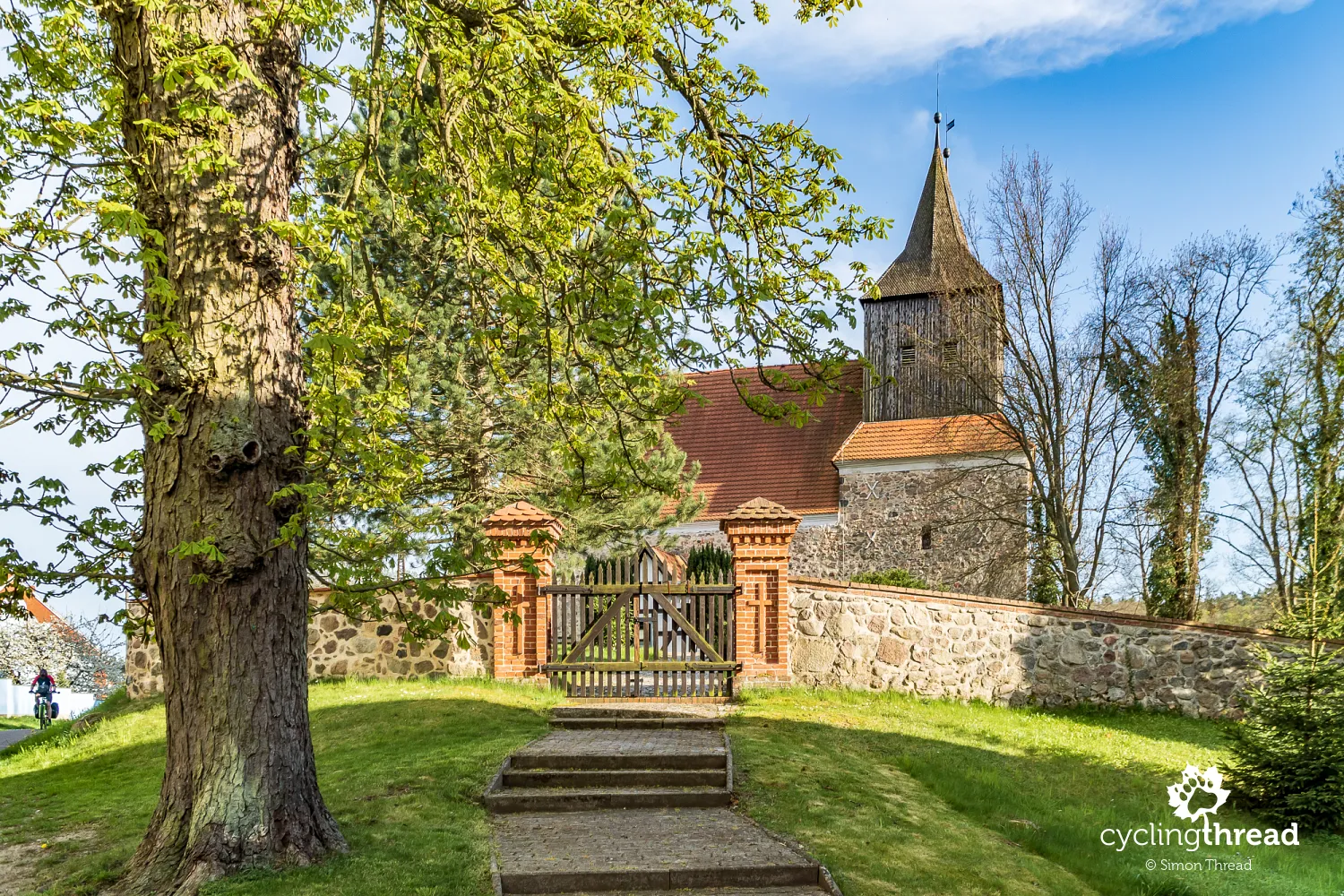
The only Tesla factory in Europe
The western part of the Oder-Spree-Tour loop is arguably the least interesting, though it doesn't lack good cycling roads or places to see. For me, a major attraction on these kilometers was the Tesla Gigafactory. Although the huge facility, for which a large swath of forest was cut down near the town of Erkner, is still under construction, it's worth approaching one of the overpasses over the A10 motorway, the so-called “ring” around Berlin. The paved overpass has been blocked off, and the road closed, but Elon Musk's conglomerate's only factory in Europe is quite visible from here. This access is clearly visible on the map of our journey at the top of the page. And if the sight of the Gigafactory isn't what you dream of, you can spend three days in Brandenburg instead of four and comfortably shorten the route by traveling from Bad Saarow north, straight to Fürstenberg (Spree).
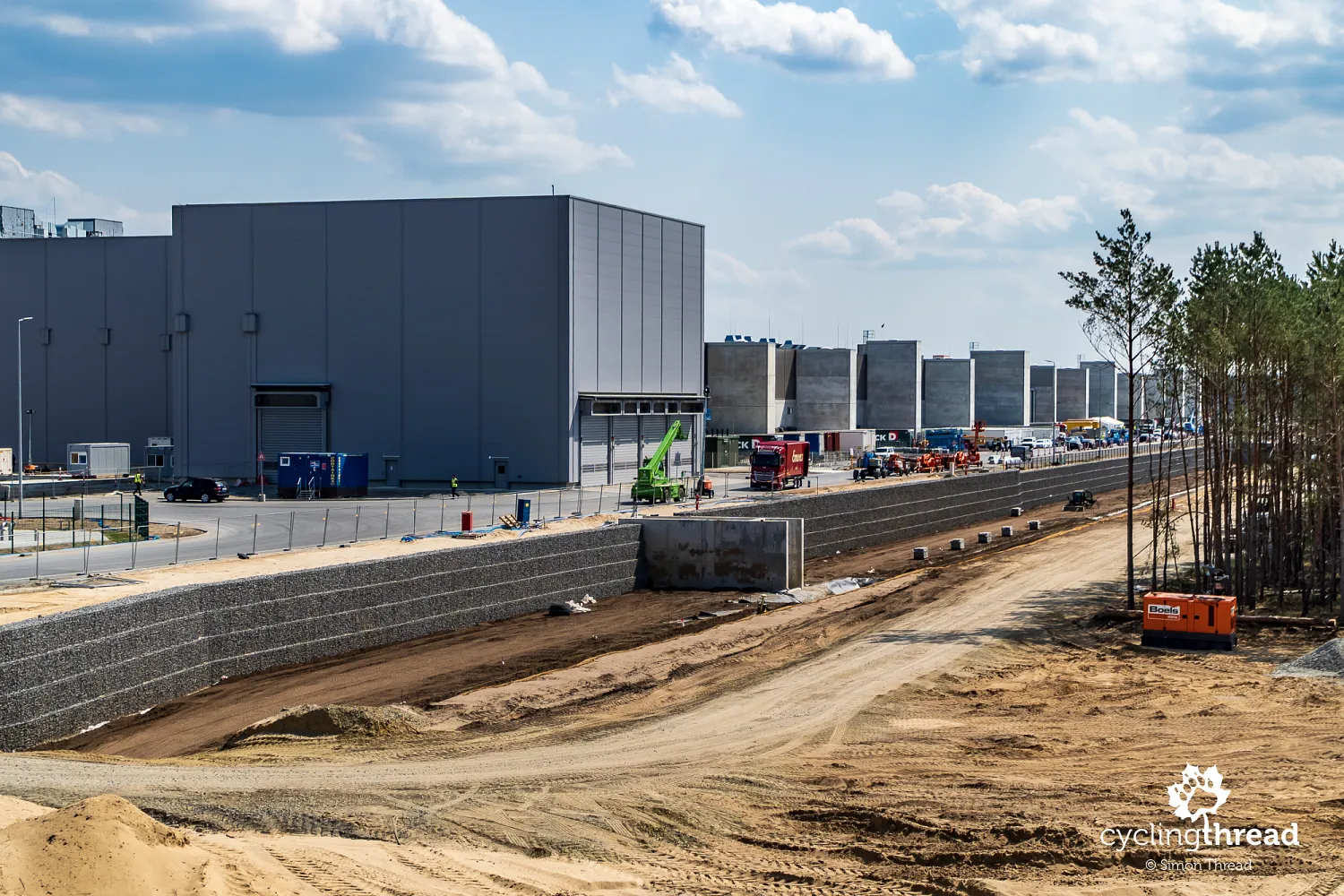
Spree with Oder-Spree and Frederick William canals
Before the town of Erkner, the bike route first crosses the Oder-Spree Canal, and shortly thereafter, the Spree itself. This is one of the oldest canals in Brandenburg and one of the most interesting technical monuments in the region. The Oder-Spree Canal was opened in 1891, connecting the Dahme river (a tributary of the Spree) with the Oder. This created a waterway that is 85 kilometers long and connects the catchment areas of the Baltic Sea and the North Sea. However, before the modern Oder-Spree Canal was constructed, navigation between Berlin and the Oder was made possible thanks to a canal built (or rather: completed) by Frederick William I, after whom the canal was named. Our bike route crosses the Spree, the Oder-Spree Canal, and eventually the Frederick William Canal several times, running along them for many kilometers on the last day of the trip, giving it a distinctly waterside character.
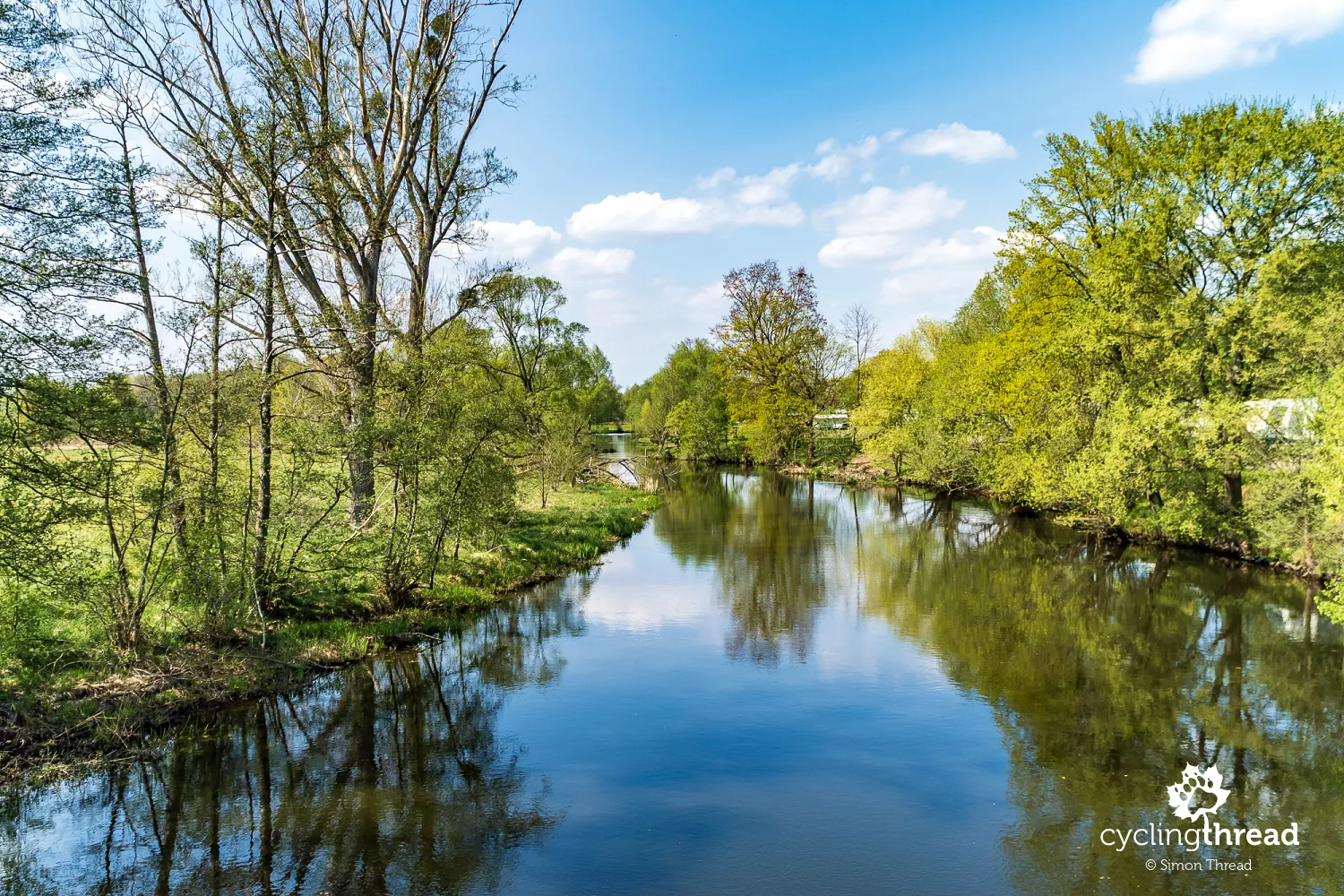
Cathedral, modern market and transportation hub
Fürstenwalde (Spree), like Erkner, the earlier town on the route, is located along the railway line from Frankfurt (Oder) to Berlin. This convenience allows planning either a two-/three-day trip along the route Frankfurt-Neuzelle-Beeskow-Bad Saarow-Fürstenwalde, or even a one-day journey from Fürstenwalde to Frankfurt. German regional trains run this route every hour, facilitating a quick return either to the car left in Frankfurt or Erkner. In Fürstenwalde itself, it's worth seeing the Cathedral of St. Mary and the reconstructed, contemporary market square with the historic town hall. Don't expect fireworks, just that specific situation where the historic medieval fabric of the city is combined with post-war, somewhat specific modern sensibilities. Due to the extensive damage after World War II, the city can boast only a few monuments from earlier periods. On the main shopping street in Fürstenwalde, you can look for places for an inexpensive meal.
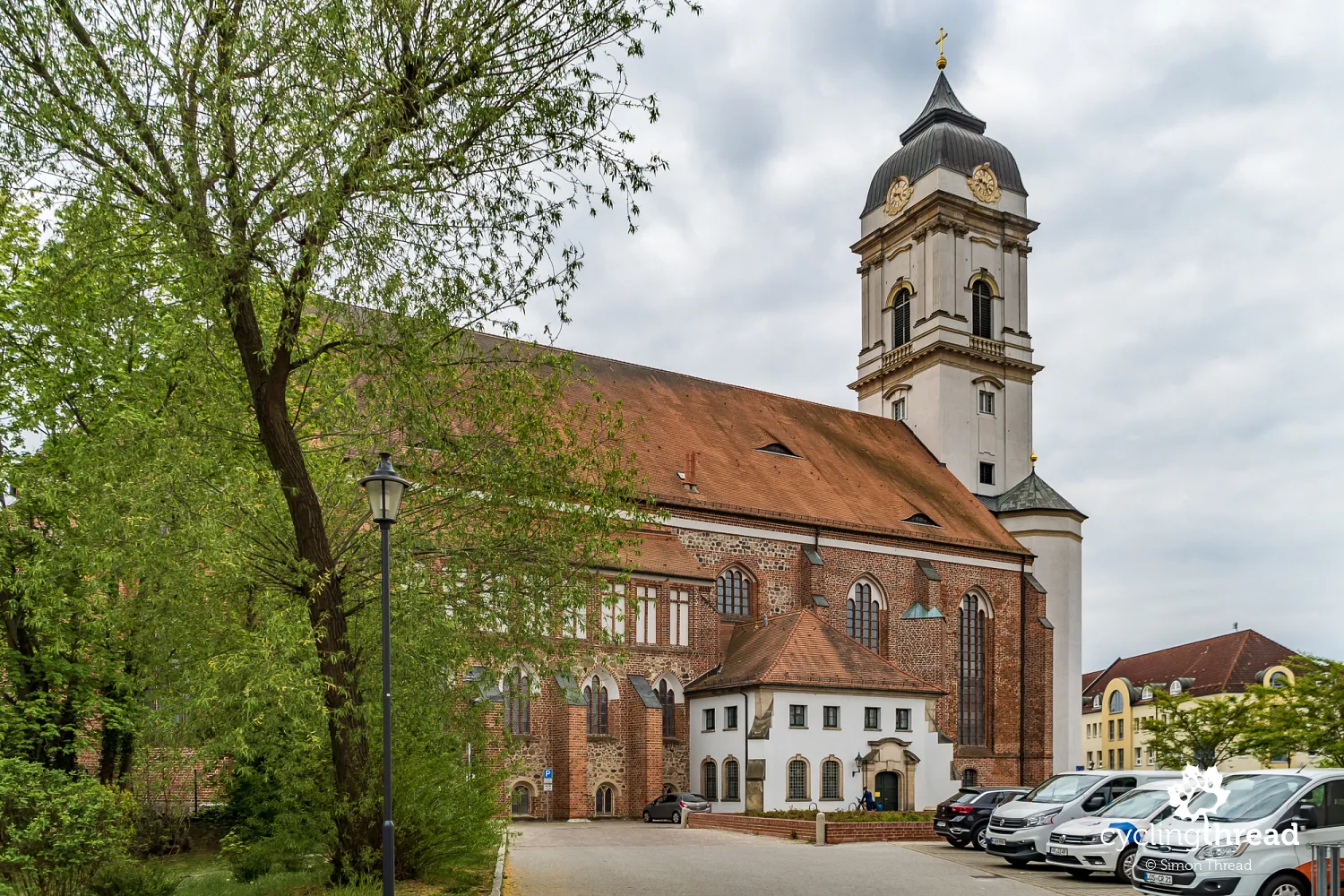
Excellent cycling roads along the Spree and canals
However, past Fürstenwalde, the route becomes immensely enjoyable again and is truly worth considering even for a one-day excursion in Brandenburg. Shortly after leaving the city, we entered narrow forest asphalt roads closed to cars, which first meander through dense, pleasant forests and then suddenly lead onto a long, wooden pedestrian-cycling bridge over the Oder-Spree Canal. With no towns nearby, this bridge serves as another example of infrastructure built by the Germans solely for local tourist traffic. Interestingly, when we reached the bridge, a team of professional cyclists in German national team jerseys was just coming off it and continued in the direction from which we had come - hard to find better proof of the excellent quality of the cycling roads.
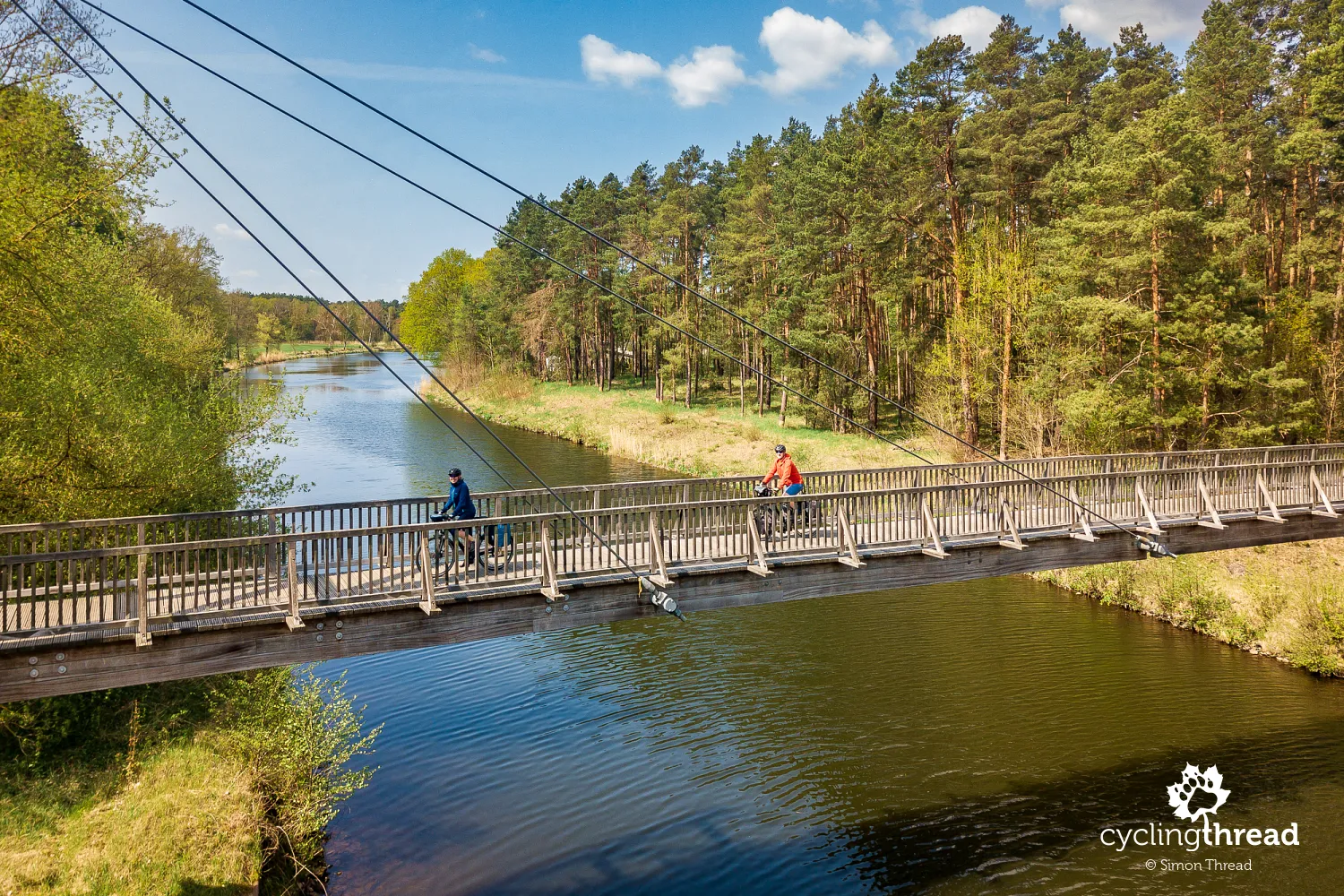
Four locks on the Oder-Spree Canal
Not further than a kilometer from the bridge over the canal is the Kersdorf Lock, one of four on the Oder-Spree Canal. Built in 1891, it initially had one chamber, with a second constructed in 1914. The heavy blue construction is the lift gates, which in 1928 replaced the previous classic design gates. If time allows, it's worth stopping at the lock - there's access across the top of the dam - and waiting for the chance to observe the locking process. The last time we watched a lock in operation was during a bike tour of the Elbląg Canal, but the hydraulic structures on the Oder-Spree Canal are much larger.
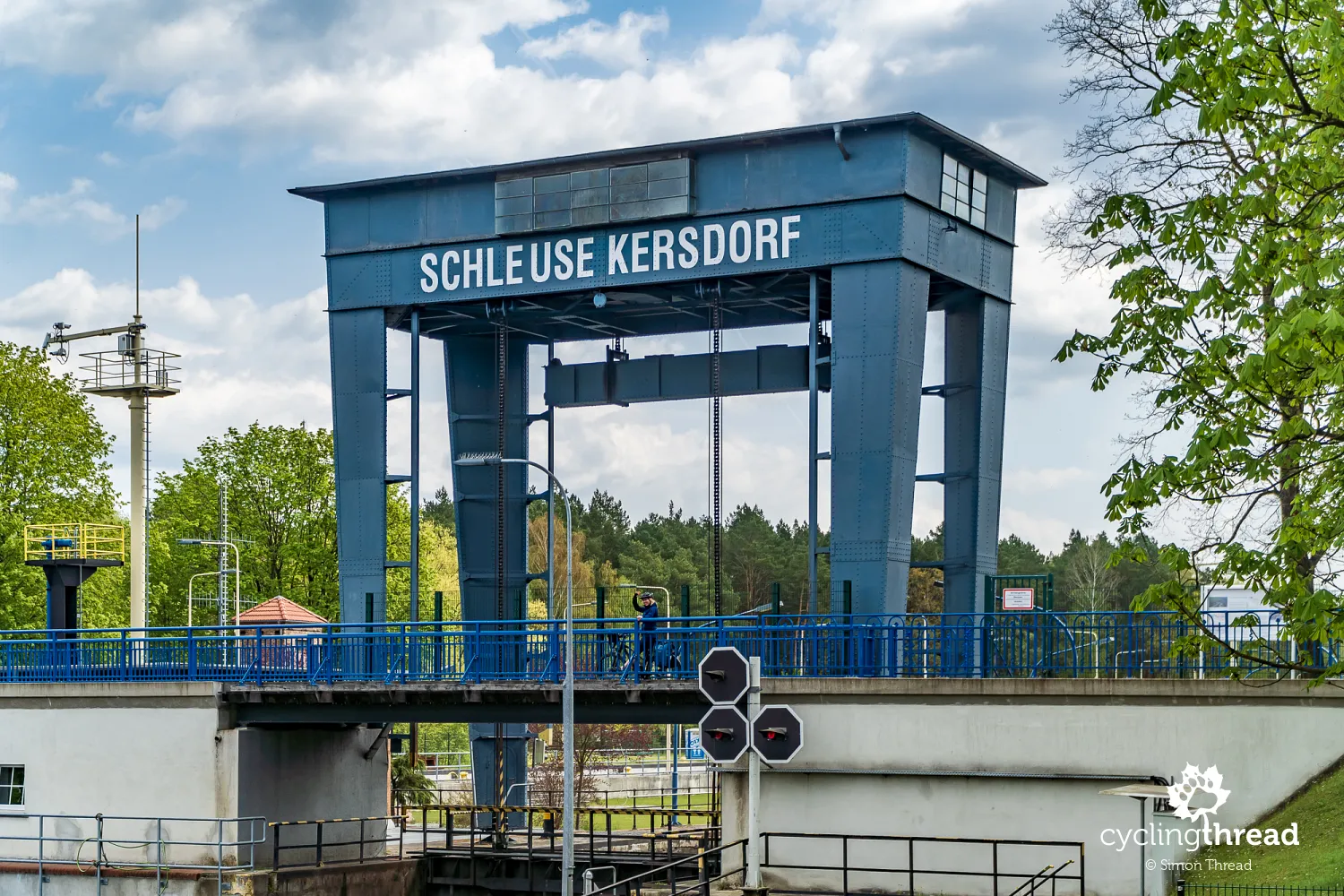
Soon after the Kersdorf Lock, the cycling trail again impresses - this time leading the cycling tourist on a narrow strip of land between the main course of the Spree (to the right) and the Oder-Spree Canal (to the left). We happened upon a moment when, on one side, a four-person rowing boat with a coxswain was gliding down the Spree, and on the other, a tugboat was pushing a dredging barge towards its destination. I suspect this is another symbolic sight - the Spree as a body of water used mainly for recreation and water sports, whereas the Oder-Spree Canal serves as a transregional transport route. The photo also shows a clear difference in water levels between the Spree and its canal, maintained precisely by the Kersdorf Lock.
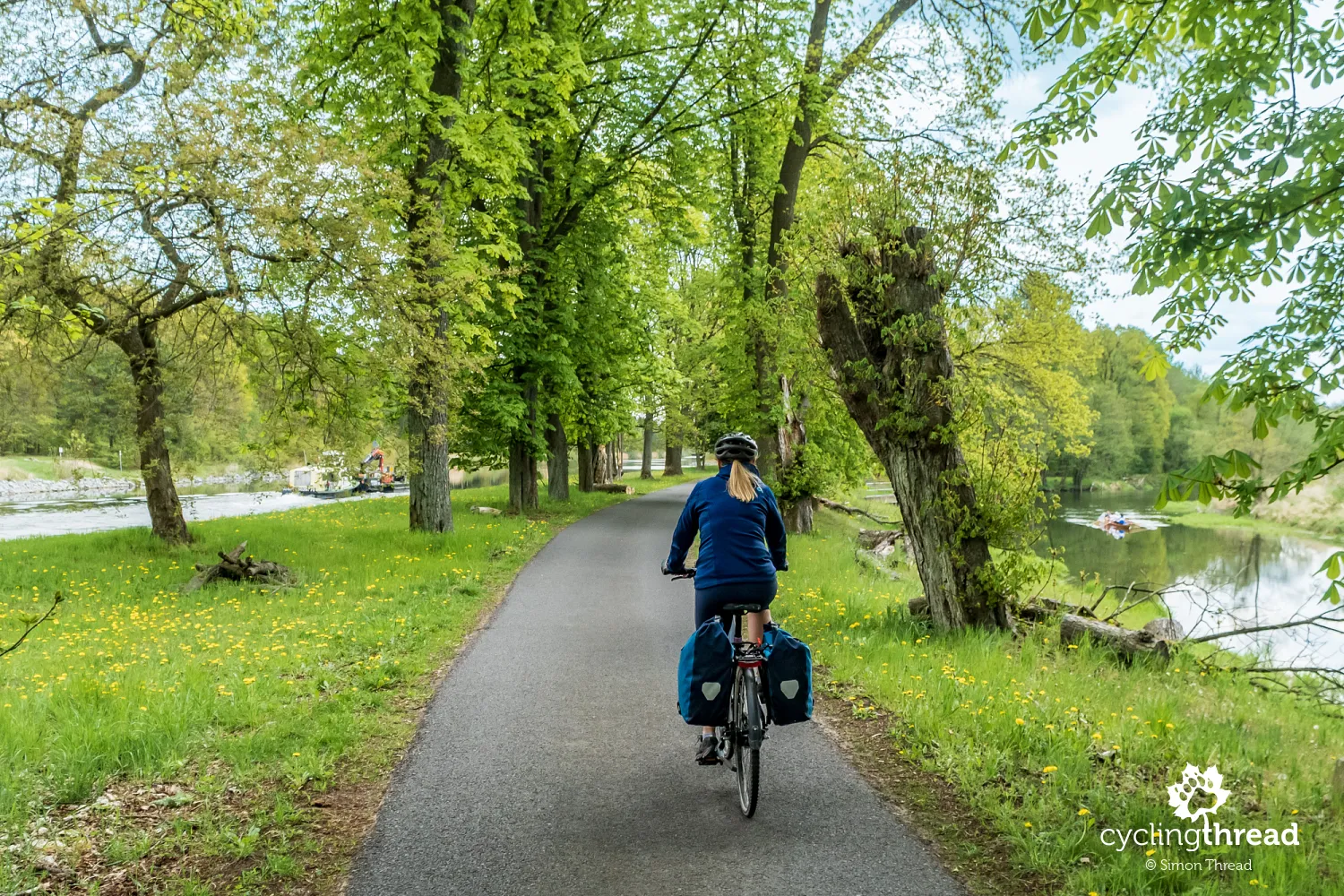
The Frederick William Canal came first
With the Spree meandering on our right, we soon arrived at the small, forested village of Neuhaus (Spree). The quiet and peace here are striking - excellent surroundings for a cycling escape from the big city. In Neuhaus, we came upon an old wooden drawbridge connected to a historic lock. This is where the Frederick William Canal (Friedrich-Wilhelm-Kanal), connecting the waterways of the Oder and the Spree and enabling navigation from Berlin to Wrocław for 200 years, began. It was built between 1662-1668, and from Neuhaus led to Brieskow, located near Frankfurt. Over 27 kilometers, it had 13 locks, allowing boats to overcome a total of about 27 meters in elevation difference between the Spree and the Oder. Today, the old canal has solely touristic significance and again fits perfectly into the recreational mood of this part of Brandenburg.
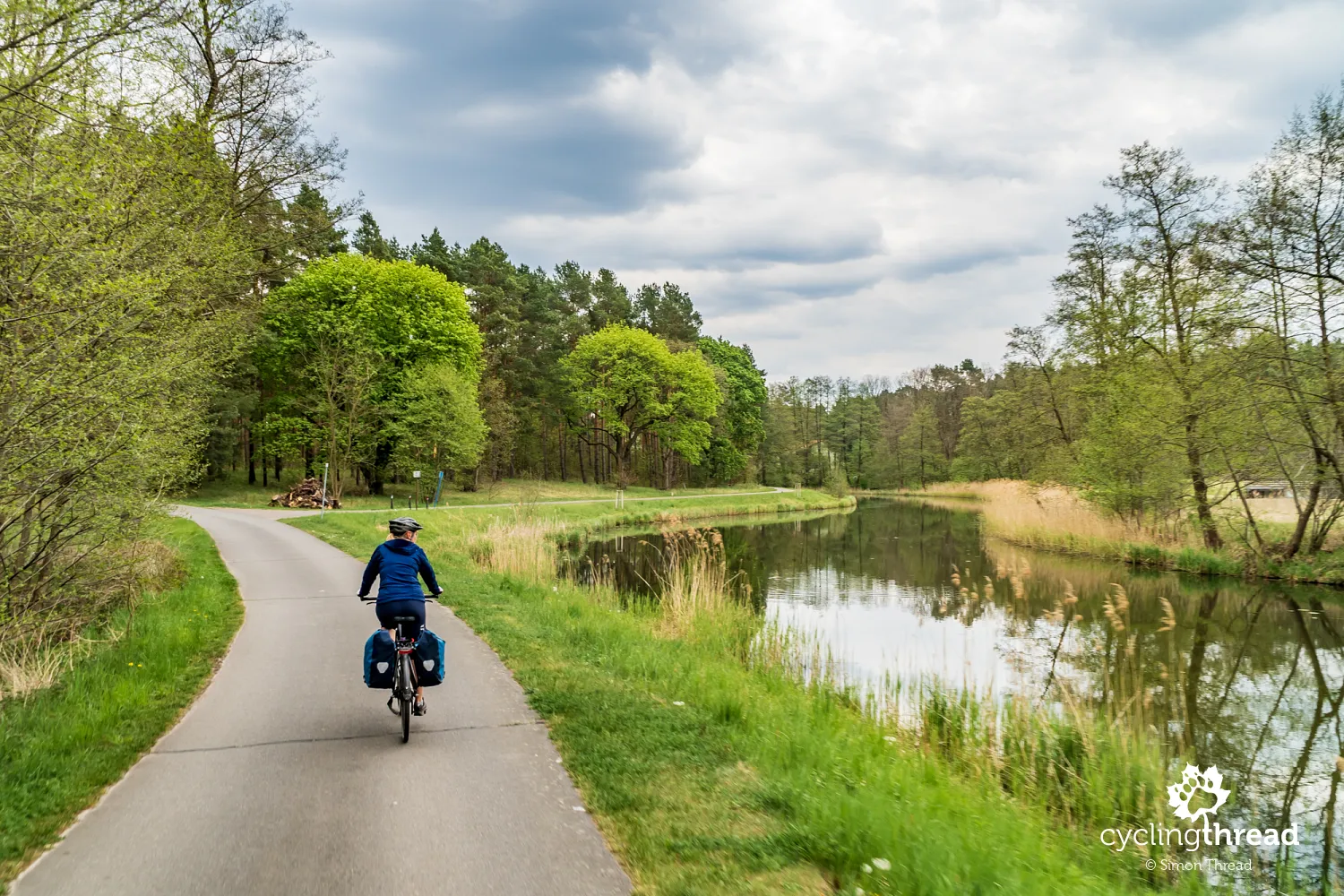
Most of the old locks we passed while riding the excellent, intimate cycling road along the Frederick William Canal were heavily weathered by time. Those we saw seemed like they were in their last years, during which tourists still have the chance to see them. Perhaps this was in mind for the creators of the painting covering the lock gates in Groß Lindow. The three-dimensional image painted for tourists riding on the opposite bank of the canal creates the deceptive impression that a small boat is just entering the lock. Only at home did I see more details - a heron, flying ducks, the shadow cast by the gates on the plaque with the name and date of construction, but above all, the "open" gates painted by the artist, giving the scene such realism.
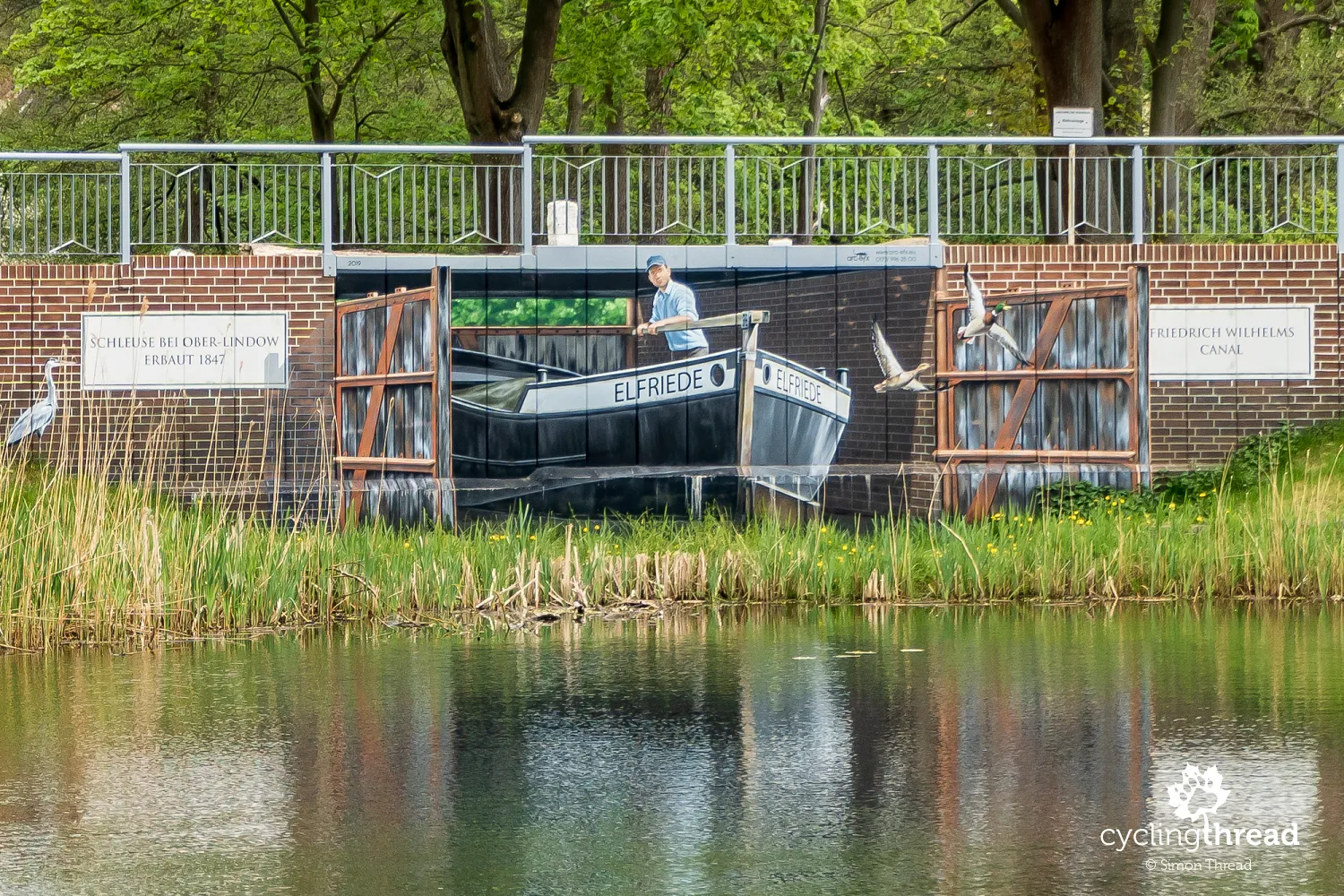
Cycling bridge to the Schlaube Valley
On the last stretch of the route, past the town of Müllrose, another wooden pedestrian-cycling bridge crosses the Oder-Spree Canal. Though our route does not run this way, we take a curious glance at it. Here begins the nearly 50-kilometer Schlaubetal-Radtour cycling route that runs to and from the Schlaube Valley, leading to the impressive section of the bike path by the lake, which we marveled at on the first day near the Siehdichum forester's lodge. The fact that a dedicated cycling route runs through the small Schlaubetal must testify to our enchantments with the ride through the beech forests of Brandenburg not being coincidental. I'm jotting down this short route on my long list of inspirations.
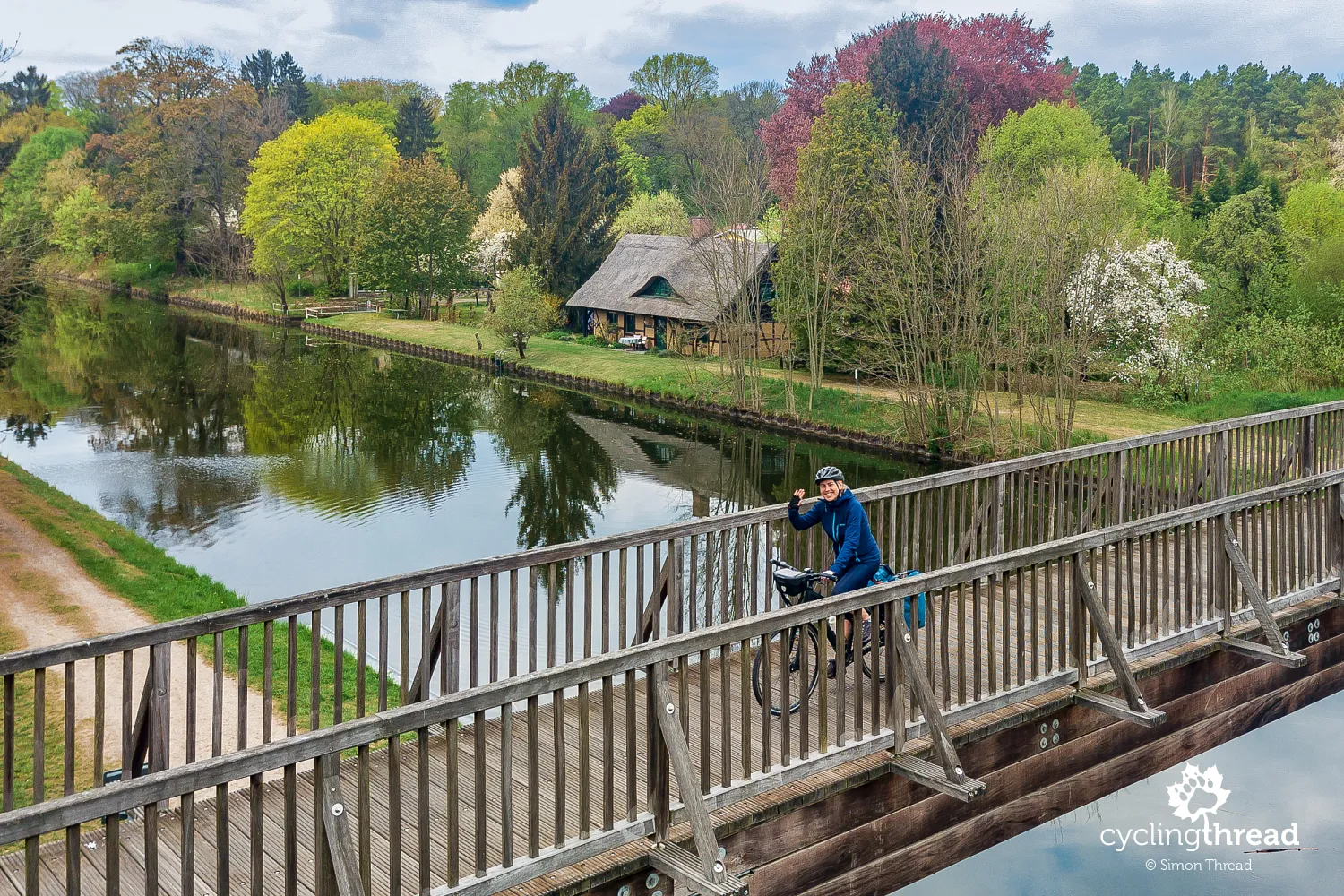
Who is the Oder-Spree-Tour for?
As is typical in Germany - really for everyone. No average, healthy, strong cyclist will have the slightest problem cycling the loop between Frankfurt and Berlin. But the route will also be excellent for others, including those weaker or requiring increased safety: for families with children in trailers, and with increased attention on segments in general traffic - I think also for children riding independently. Remember, there aren’t many such segments and, if I recall correctly, most of them are near Erkner. Climbs - seems there's one - when exiting Frankfurt. Older individuals will also navigate the route without difficulty. I even think that Oder-Spree-Tour is a route more worth riding, certainly more varied than the famous Oder-Neisse route.
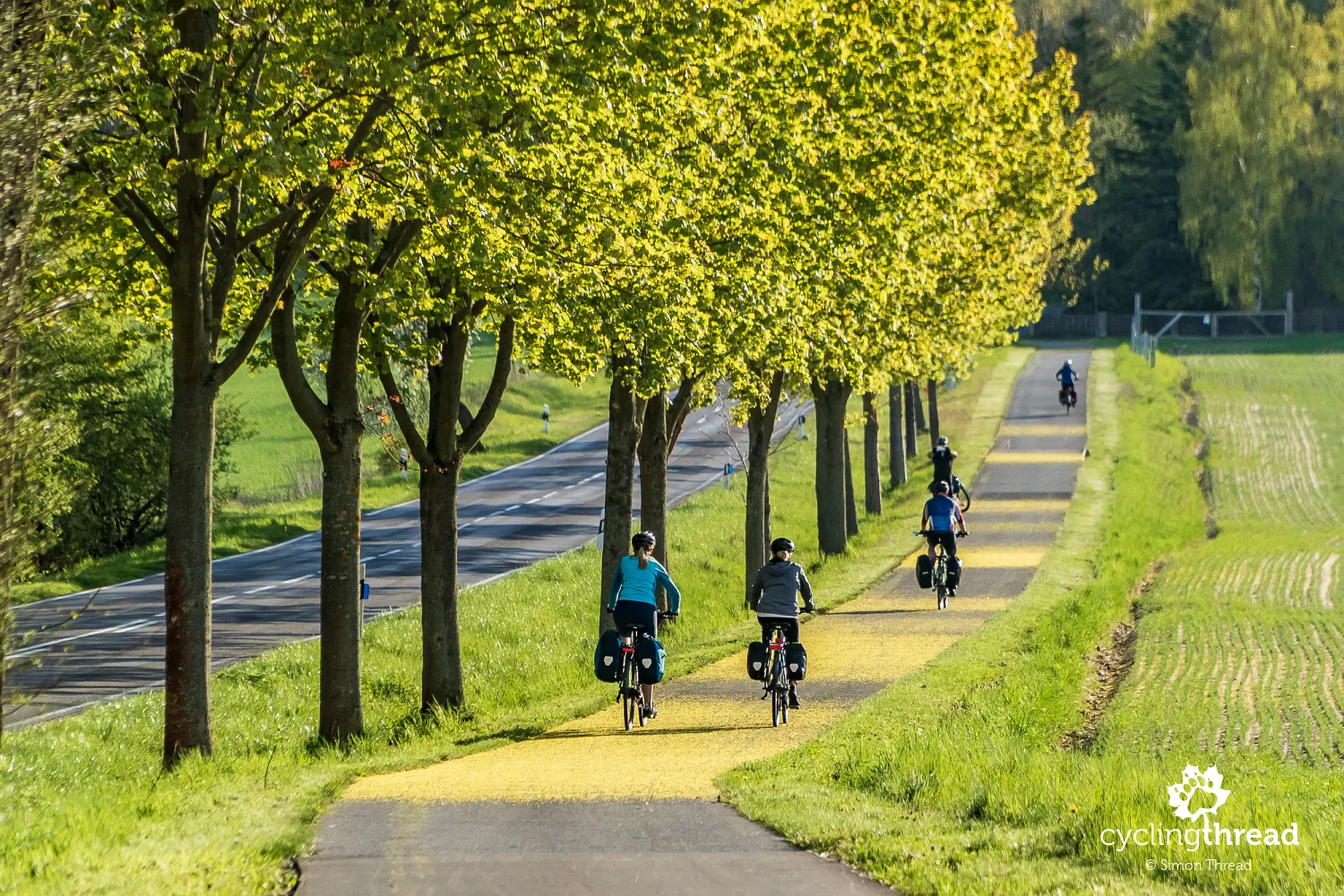
7,000 kilometers of cycling roads
Just in Brandenburg alone, there are as many as 7,000 kilometers of cycling roads. It's easy to calculate that across the entire region, we could organize over 100 different one-day cycling excursions, each running only on safe, yet undiscovered cycling infrastructure. And if you add that every cycling trip, even just for one day, is an excellent opportunity for active leisure, discovering new places, listening to unheard stories, and of course, spending time in a pleasant atmosphere with a loved one or friends, you can imagine the vast recreational and social capital a region possesses with developed, safe cycling infrastructure. So, I encourage you, during your stays in very bicycle-friendly Germany, to observe the way they care for bicycle traffic - both daily and touristic, and then transfer similar expectations towards local governments in your country.
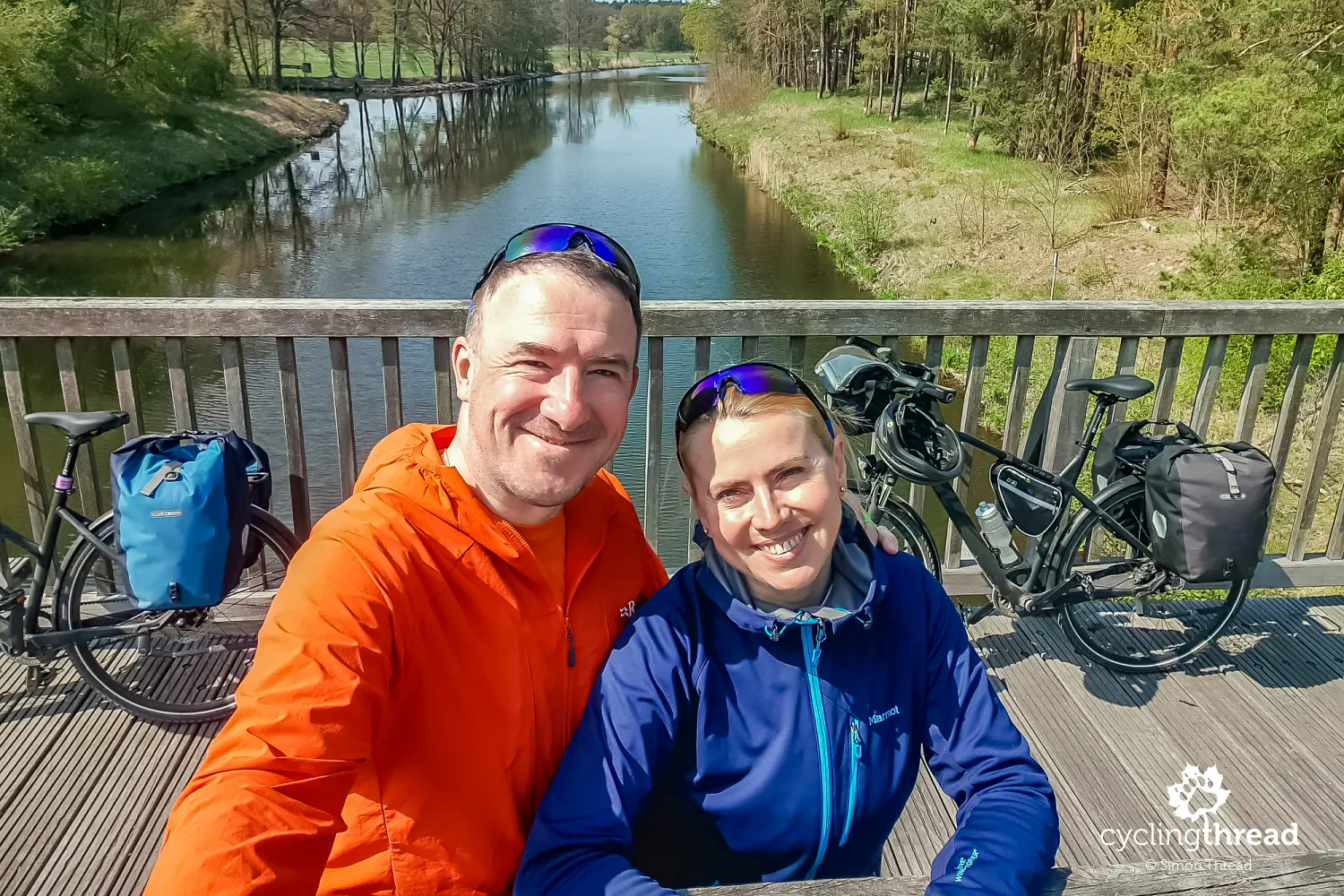
Ambassadors of cycling tourism in Brandenburg
Finally, we are delighted to announce that as ambassadors of cycling tourism in Brandenburg, we will be inviting you on cycling trips to Brandenburg for the next two years. Our plans include further segments of the Tour Brandenburg, we would like to ride also the popular Berlin-Usedom cycling route. But we are also highly anticipating the route from Szczecin to Berlin, which will soon gain a major attraction in the form of the new-old cycling bridge in Siekierki. It will surely be a fantastic crossing connecting Poland and Germany - West Pomerania and Brandenburg. So, we say "see you" in our next reports from Brandenburg :-)
Back to topHave a safe ride! 💚
Simon Thread
(Szymon Nitka)
I'm a passionate cycling traveler and the voice behind Cycling Thread. I explore Europe on two wheels, documenting the most scenic routes, inspiring places, and cyclist-friendly practices. My writing blends personal experience with practical insights and a deep love of travel. I'm also a contributor to National Geographic Traveler magazine.



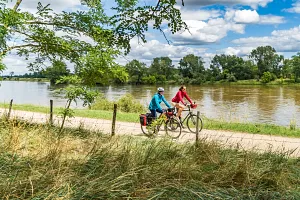
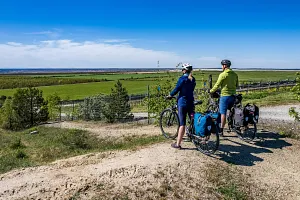
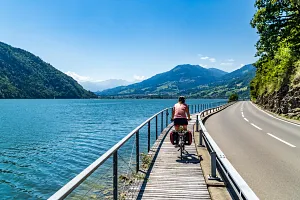
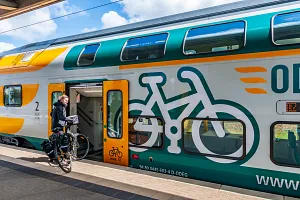
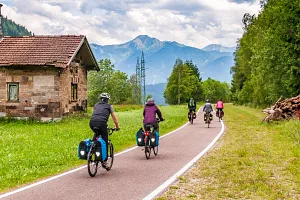
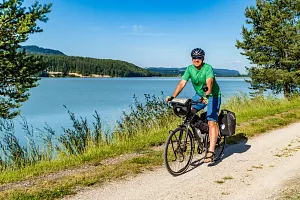
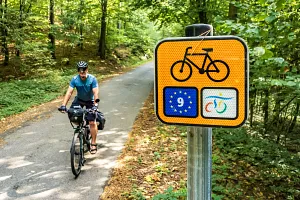
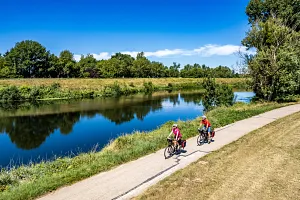
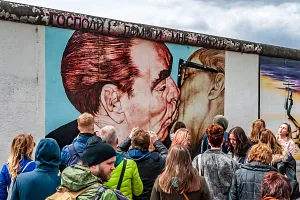
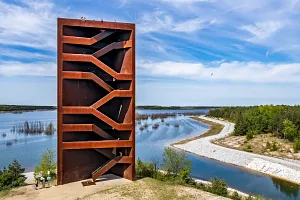
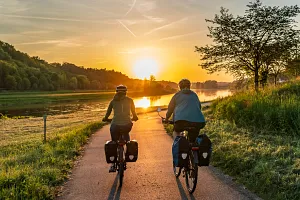
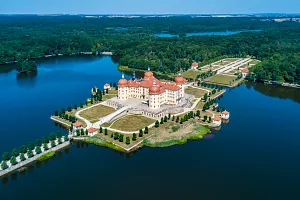
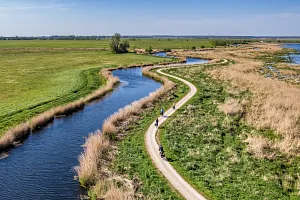
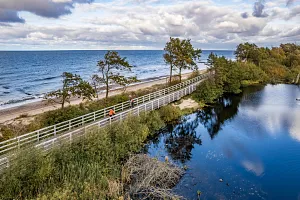
Your Comments
Add new comment